Negative Pressure Ventilation
The cuirass, rocking bed, and negative pressure respirator (iron lung) are among the featured devices.


Pioneers
Inventors and pioneers in the development of negative pressure ventilation devices are featured.
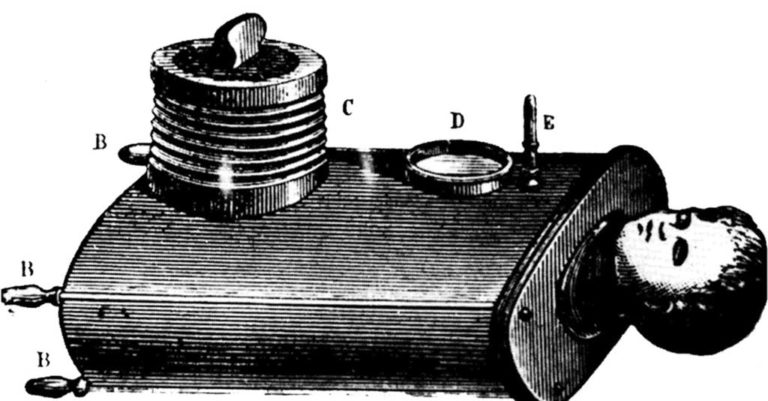
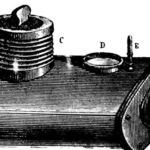
1854 Eugene Woillez, Spirophore
In 1854, Eugene Woillez described the Spirophore, the forerunner of the Iron Lung. This negative pressure ventilator was hand powered by use of a bellows. In the era where fears of premature burial were prevalent, parents would sometimes insist that their stillborn babies be ventilated for long periods of time before being declared dead. It was also used for near drowning victims and for recovery from snake bites. In the case of snake bites, the patient was ventilated until the neurotoxins causing diaphragmatic paralysis were broken down, and recovery was assured.
The device included a hand crank for the operator to turn to power the unit and an adjustable neck collar. Woillez did not patent his device.
The device included a hand crank for the operator to turn to power the unit and an adjustable neck collar. Woillez did not patent his device.
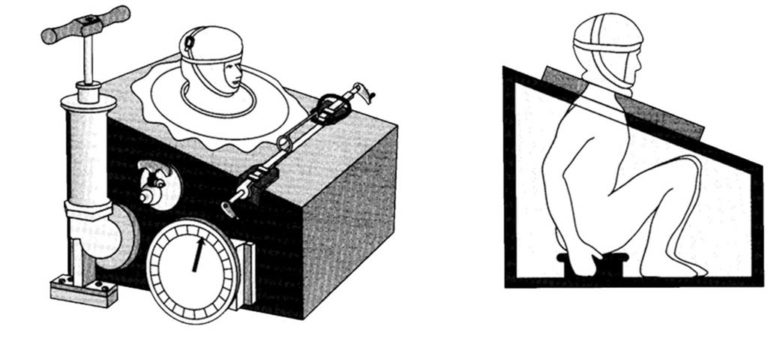
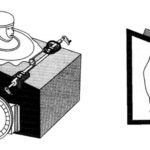
1864 Alfred Jones, 1st Patent
Alfred E Jones of Lexington, Kentucky, obtained a patent for a negative pressure ventilator. He claimed it could cure conditions such as paralysis, rheumatism, weakness, asthma, bronchitis, and deafness.
Image from Emerson's "The Evolution of Iron Lungs" shared byLynda Goodfellow
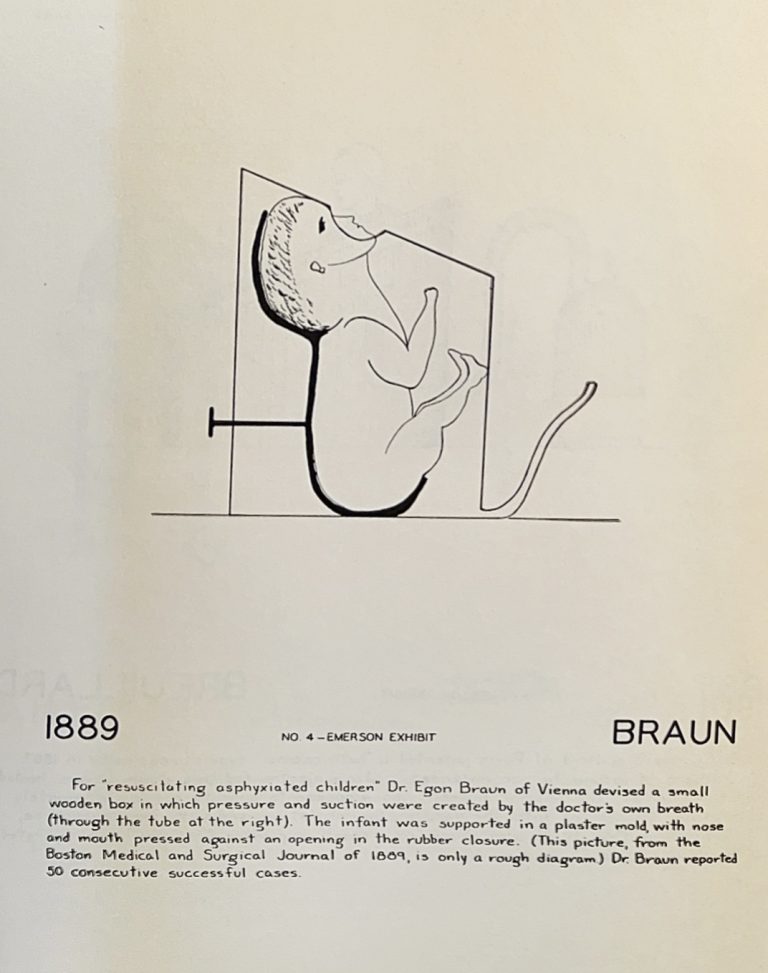
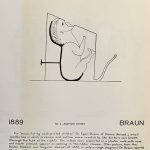
1889 Braun's Infant Resuscitation Box
Dr. Egon Braun, an Austrian physician, developed an early device used in infant resuscitation. After the infant was placed in a wooden box, the operator blew into the attached pipe to compress the infant’s chest. Air then escaped out of the pipe, causing a negative pressure that caused the infant’s chest to expand for inspiration. This was repeated at a rate to approximate a respiratory rate.
Image from Emerson's "The Evolution of Iron Lungs" shared by Dennis Glover
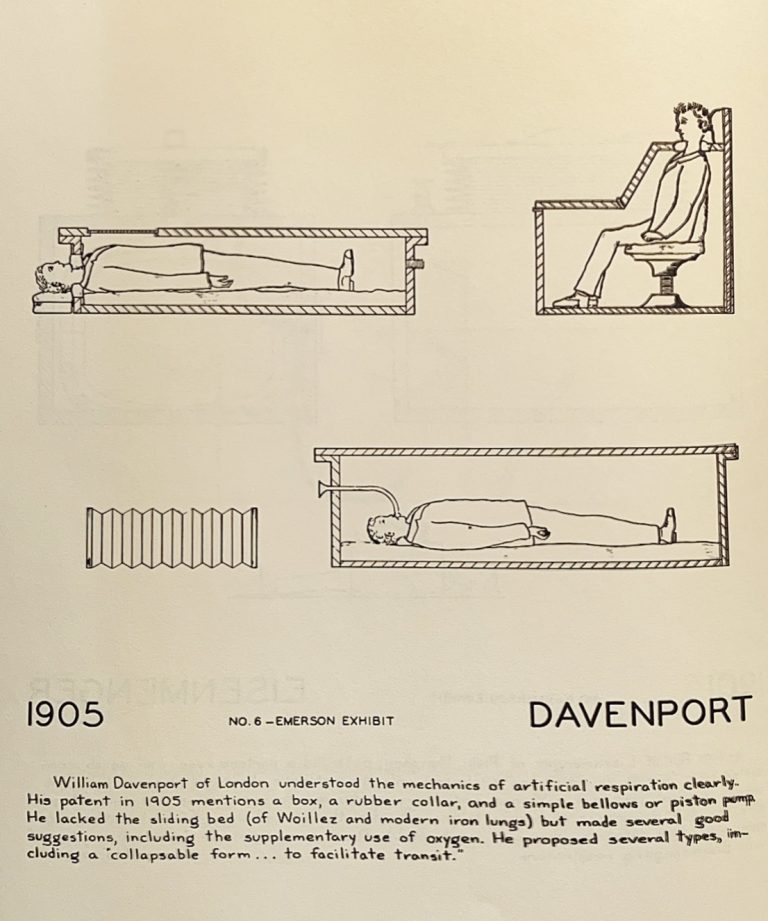
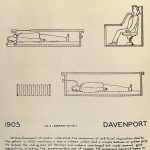
1905 Davenport Ventilator
In 1905, William Davenport's ventilator was patented. His device suggested the use of supplemental oxygen and included a collapsible form to facilitate transit.
Image from Emerson's "The Evolution of Iron Lungs" shared by Lynda Goodfellow
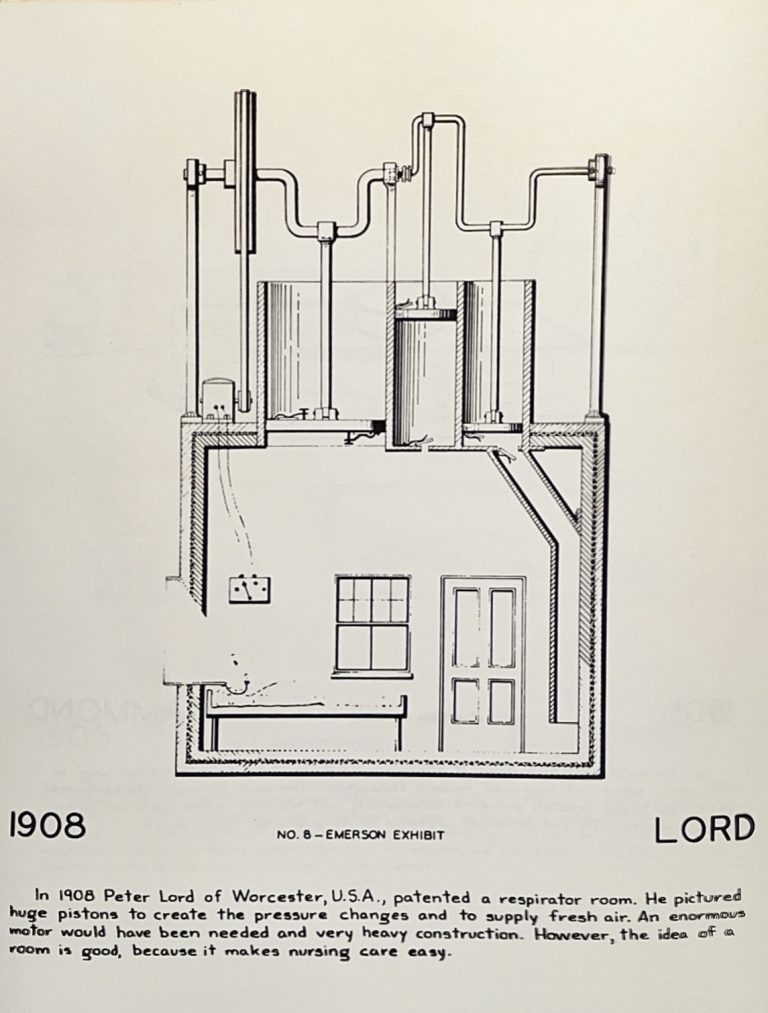
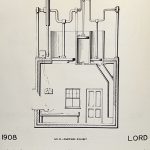
1908 Lord's Respirator Room
In 1908, Peter Lord patented a proposed respirator room which would require large pistons to create pressure changes.
Image from Emerson's "The Evolution of Iron Lungs" shared by Lynda Goodfellow
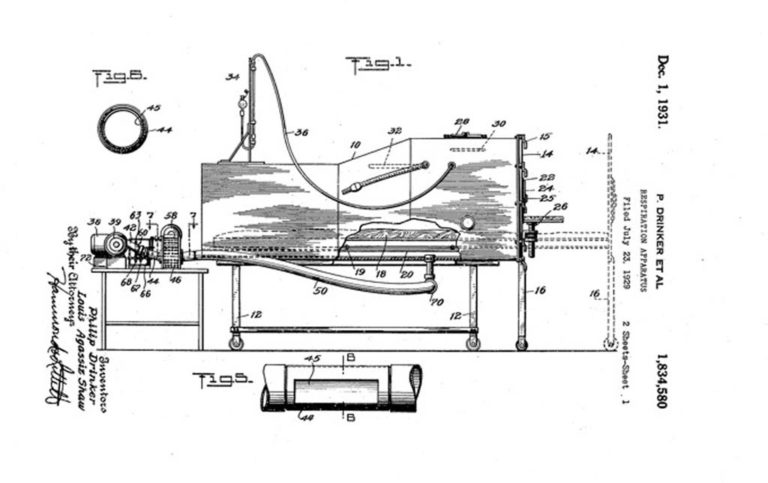
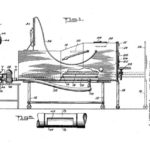
1929 Phillip Drinker and Louis A. Shaw
Dr. Phillip Drinker (1894-1972) and Dr. Louis Agassiz Shaw (1886-1940) were faculty members at Harvard University when they developed the first negative pressure “respiration apparatus” in 1928. They applied for a patent in 1929 and received it two years later.
The bellows was capable of generating pressures of -60 cmH2O and rates between 10 and 40 breaths per minutes. The pressure was initiated at -18 cmH2O and the patient was asked to count out loud as pressure was adjusted until the patient could no longer speak.
The bellows was capable of generating pressures of -60 cmH2O and rates between 10 and 40 breaths per minutes. The pressure was initiated at -18 cmH2O and the patient was asked to count out loud as pressure was adjusted until the patient could no longer speak.
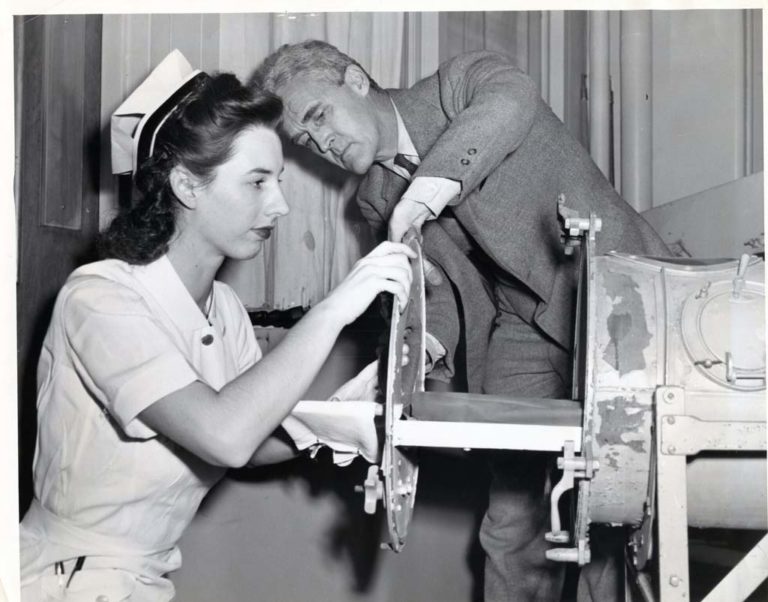
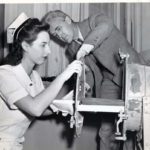
Dr. Phillip Drinker
Dr. Phillip Drinker, one of the inventors of the "iron lung" demonstrates how to adjust the neck collar on the unit.
Image from the archives of Children's Hospital of Boston.
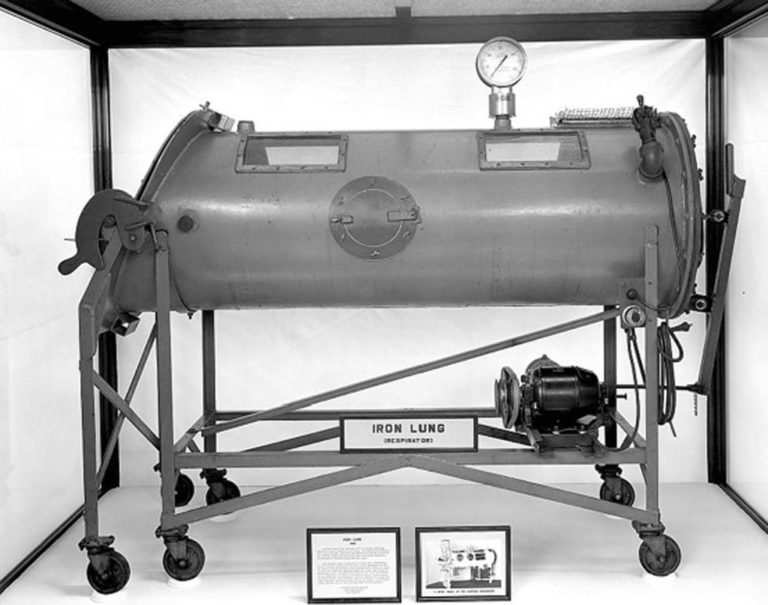
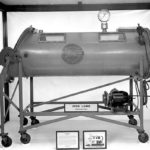
1931 John Emerson improved the "iron Lung"
John Haven “Jack” Emerson (1906-1997) an American biomedical inventor did extensive work on the negative pressure respirators which became known as “iron lungs”. Emerson’s first unit was completed in 1931 and was lighter, quieter, and cost half the price of Drinker and Shaw’s device. Emerson was sued by Philip Drinker and Harvard University for patent infringements. However, Emerson won the case and Drinker’s patents were declared invalid. Emerson’s “Old Number One” iron lung is displayed in the Smithsonian Institution.
Image from "The Evolution of Iron Lungs" shared by Dennis Glover


Poliomyelitis
This section of the gallery identifies treatment for polio during the epidemics during the 20th century.


Polio
Multiple epidemics of poliomyeltis, also known as infantile paralysis, occurred in the United States in the first half of the twentieth century. Although the name would lead one to believe it was a disease of young children, infantile paralysis affected adults as well.
In 1916, over 2,000 of the 6,000 polio deaths reported that year in the United States occurred in the city of New York. Franklin Delano Roosevelt contracted polio in 1921, leaving his legs paralyzed. In 1938, the March of Dimes fundraising campaign was established to fight and treat polio/infantile paralysis. Millions of dollars of the funds raised were directed to research to develop a polio vaccine.
When the polio epidemic peaked in 1952, nearly 58,000 cases were reported with over 21,000 of those being paralytic cases. Ventilatory support could be provided by the cuirass, rocking bed, and iron lung.
In 1949, three types of poliovirus were identified. In 1952, Jonas Salk tested the initial vaccine on himself and his family. Polio vaccine trials began in 1954 but were suspended in 1955. In 1960, Sabin's vaccine, was licensed. By 1963, a vaccine effective against the three types of poliovirus, was available.
Among celebrities who survived polio are actress Mia Farrow, guitarist Gene Simmons of Kiss, singer Neil Young, Archbishop Desmond Tutu, actor Donald Sutherland, actor Alan Alda, saxophonist David Sanborn, violinist Itzhak Perlman, movie director Francis Ford Coppola, and Katherine Jackson, (mother of Michael, Janet, LaToya,…).
In 1916, over 2,000 of the 6,000 polio deaths reported that year in the United States occurred in the city of New York. Franklin Delano Roosevelt contracted polio in 1921, leaving his legs paralyzed. In 1938, the March of Dimes fundraising campaign was established to fight and treat polio/infantile paralysis. Millions of dollars of the funds raised were directed to research to develop a polio vaccine.
When the polio epidemic peaked in 1952, nearly 58,000 cases were reported with over 21,000 of those being paralytic cases. Ventilatory support could be provided by the cuirass, rocking bed, and iron lung.
In 1949, three types of poliovirus were identified. In 1952, Jonas Salk tested the initial vaccine on himself and his family. Polio vaccine trials began in 1954 but were suspended in 1955. In 1960, Sabin's vaccine, was licensed. By 1963, a vaccine effective against the three types of poliovirus, was available.
Among celebrities who survived polio are actress Mia Farrow, guitarist Gene Simmons of Kiss, singer Neil Young, Archbishop Desmond Tutu, actor Donald Sutherland, actor Alan Alda, saxophonist David Sanborn, violinist Itzhak Perlman, movie director Francis Ford Coppola, and Katherine Jackson, (mother of Michael, Janet, LaToya,…).
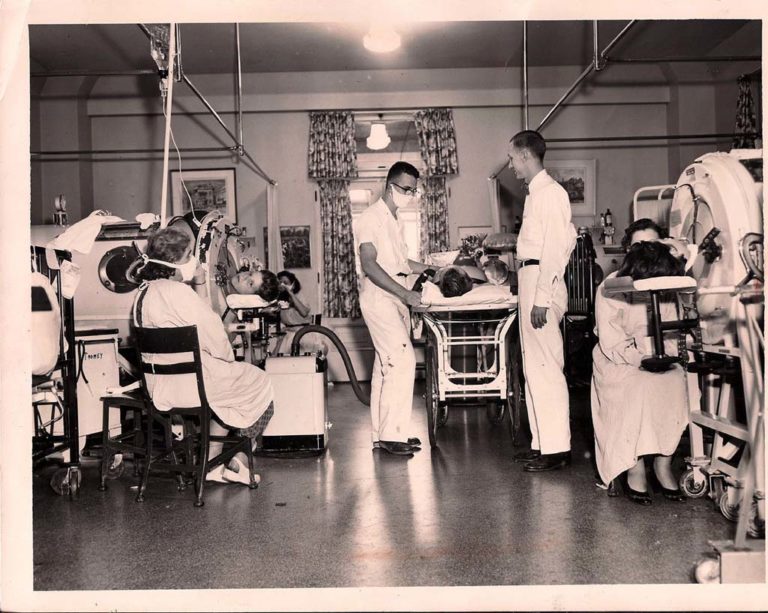
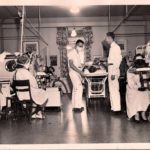
1940s Polio Ward
A photo of a polio ward from the 1940s is shown.
Image from Steve & Mary DeGenaro
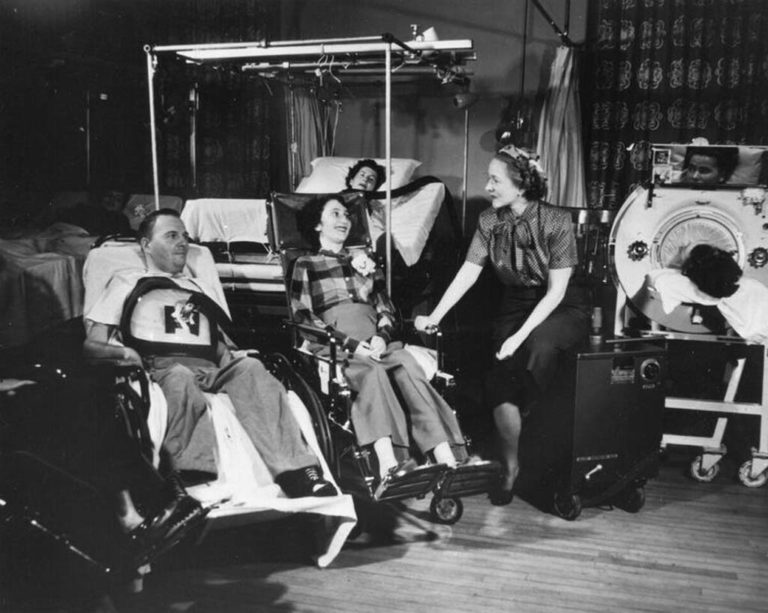
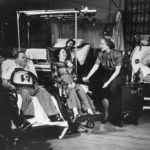
Polio Treatment Options
Several primary options for the management of polio for in the 1950s are show in this photo: the cuirass, the rocking bed, and the "iron lung."
Image provided from the archives of Children's Hospital in Boston


"The Iron Lung and Polio"
"The Iron Lung and Polio" video, produced by Mark Rockoff, MD is used with permission from Boston Children's Hospital.


Ventilators
A variety of negative pressure ventilators, also called "iron lungs", are featured.
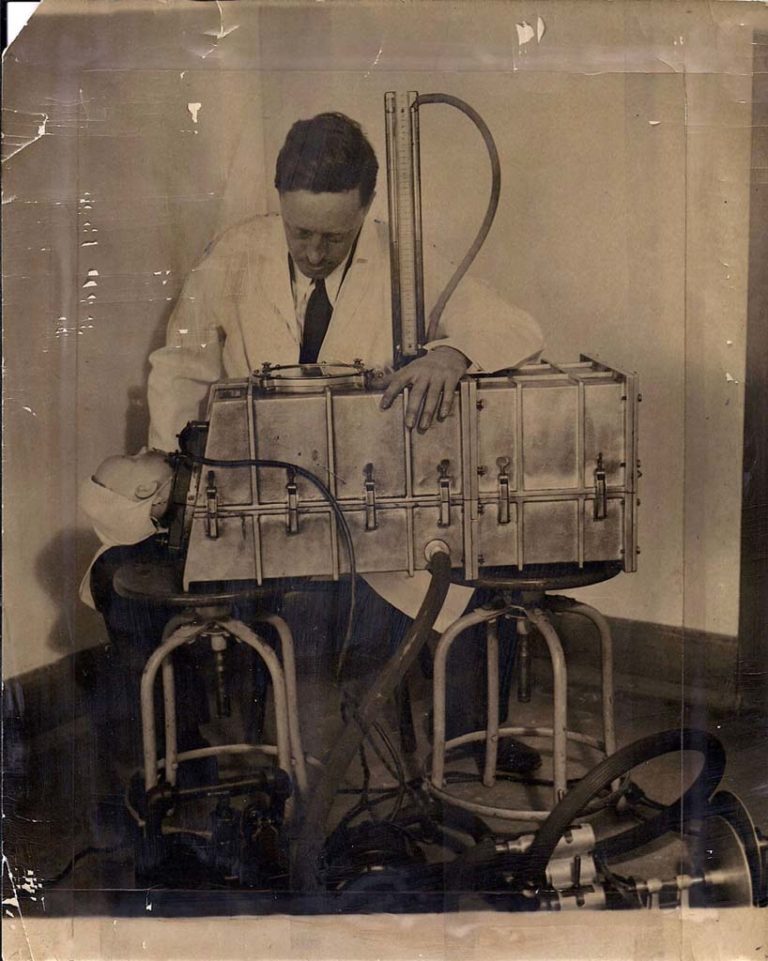
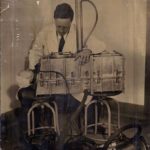
1914 Artificial Respiration Machine
A physician at County General Hospital in Denver, Colorado claimed to have developed this “artificial respiration apparatus” in 1914. This unit pre-dated Drinker and Shaw’s device by over a decade. The inventor of the 1914 device did not file for a patent.
Image from Steve & Mary DeGenaro

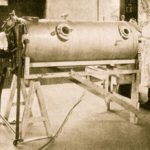
1929 Drinker & Shaw's Respirator
Dr. Philip Drinker and Dr. Louis A. Shaw developed an early negative pressure respirator. A patent was applied for in 1929 and granted in 1931.
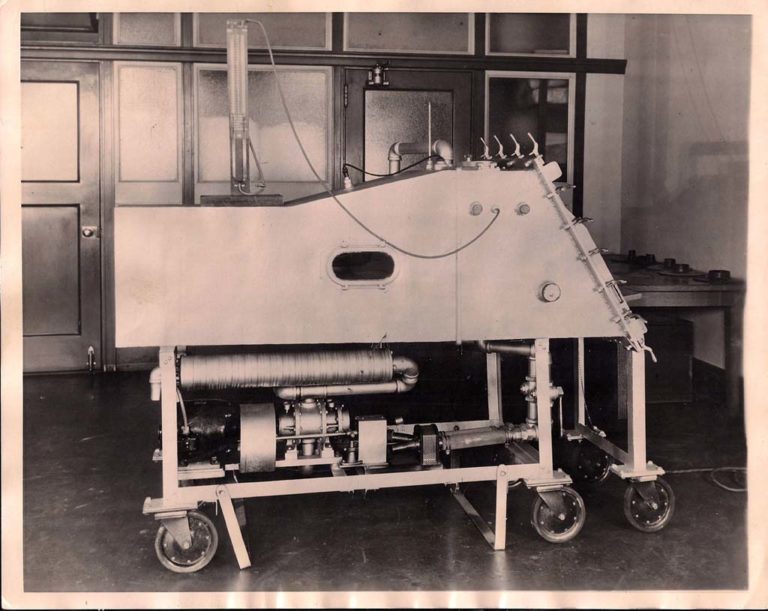
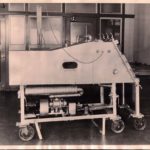
1930 Drinker Respirator
When this photo was taken on September 19, 1930, this Drinker "iron lung" at St. Luke’s Hospital in Chicago, Illinois reportedly was the only one in existence between Chicago and California.
Image from Steve & Mary DeGenaro
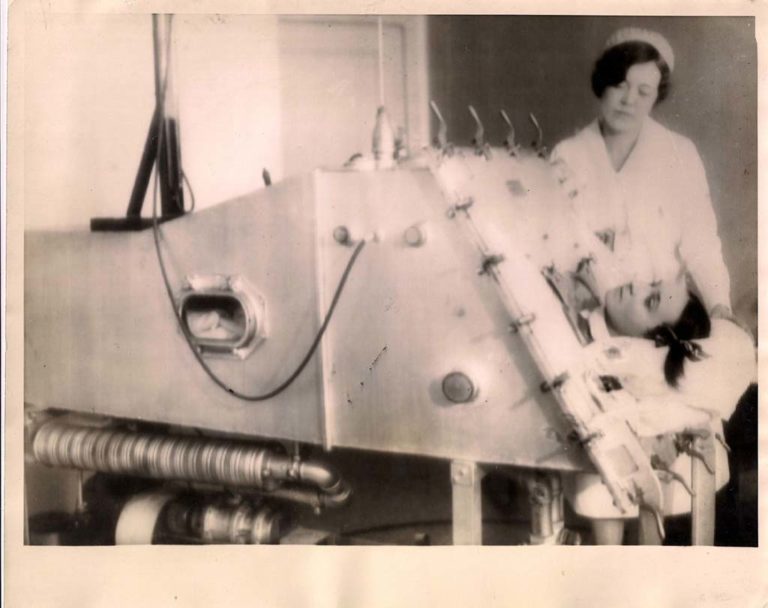
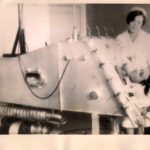
1930 Drinker Iron Lung
A 1930s model Drinker "iron lung" is shown.
Image from Steve & Mary DeGenaro
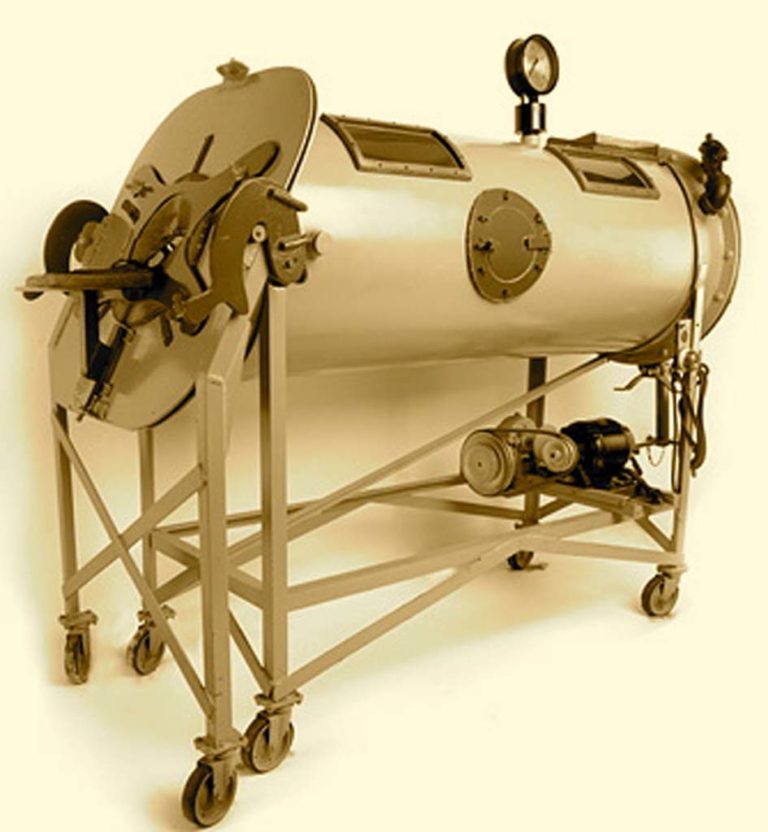

1931 Emerson's Early "Iron Lung"
The Emerson "iron lung" was less expensive and had other added innovations from the previous Drinker and Shaw negative pressure ventilator. The bed could be slid in and out to provide patient care. In addition, side ports allowed access to the patient within the tank to provide care while contained in the tank. The early models were painted blue, later models were yellow.
Image from Mark Anderson
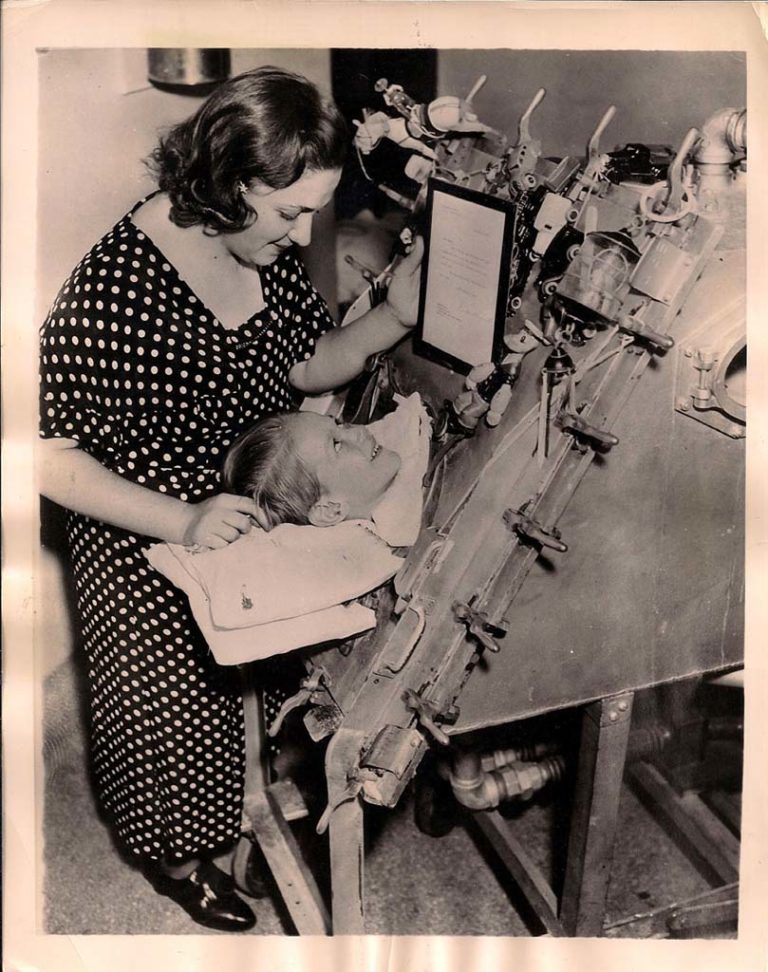
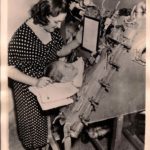
1930s Pediatric "Iron Lung"
This 1930s photo shows a young patient in an "iron lung." With the exception of the head, the patient's entire body was encased in the chamber. Materials could be positioned or mounted above the patients head for the patient to view.
Image from Steve & Mary DeGenaro

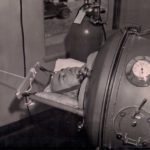
1930s
This image shows an adult patient in an "iron lung."
Image from Steve & Mary DeGenaro
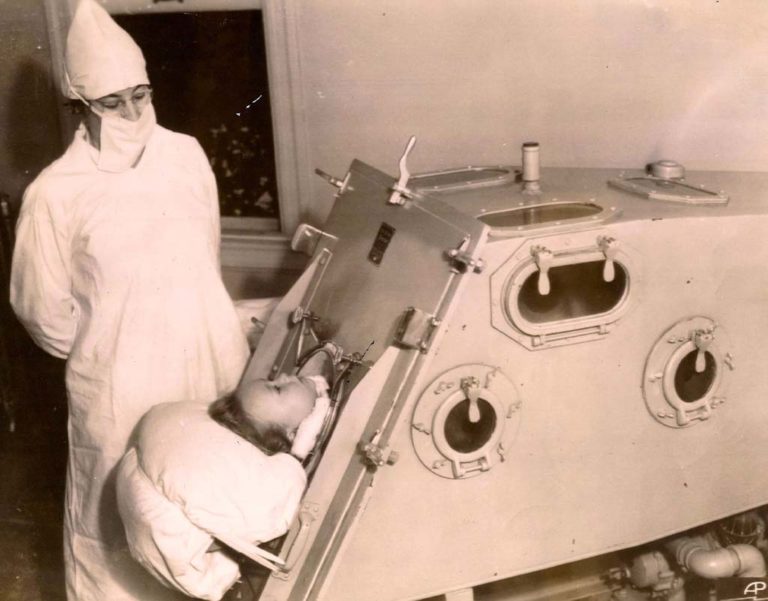
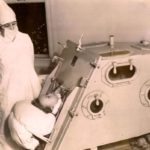
1930s
This 1930s image shows a caretaker by a pediatric patient in an "iron lung."
Image from Steve & Mary DeGenaro
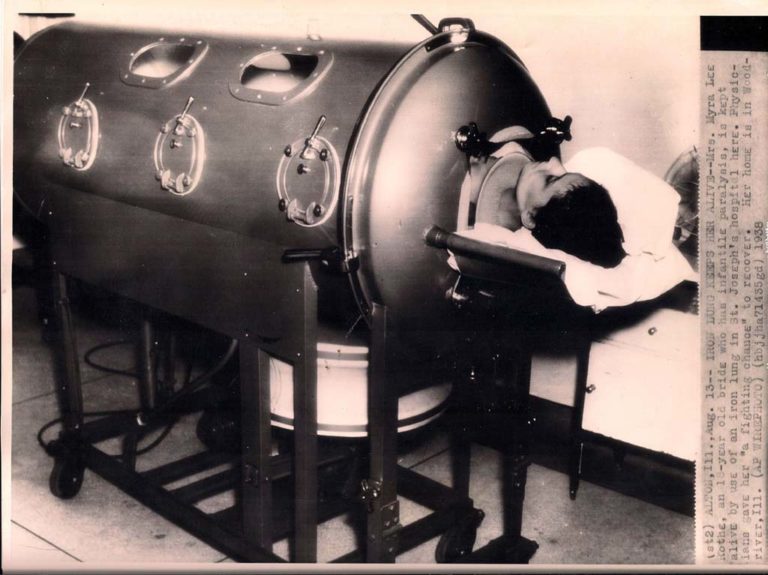
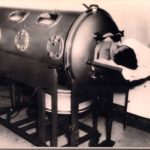
1938
In this 1938 photo from Alton Illinois, the caption states “An 18 year-old bride with infantile paralysis, Mrs. Myra Rothe is kept alive by an iron lung at St. Joseph’s Hospital here. Physicians gave her a fighting chance to recover.”
Image from Steve & Mary DeGenaro
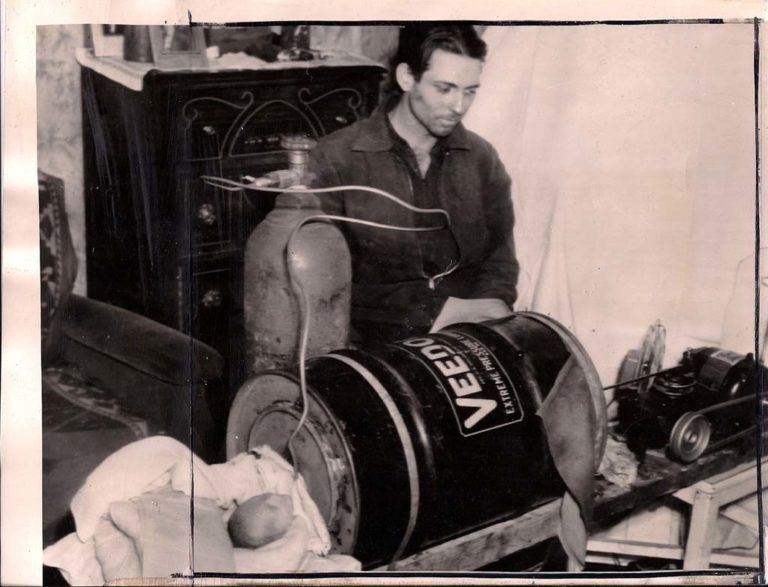
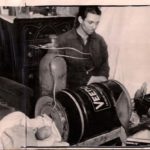
1940 Homemade Iron Lung
In this photo dated March 15, 1940, the caption stated "Homemade Iron Lung failed to save life despite ingenuity of father. James Bailey, 25 watching operation of device on his baby son, Paul which kept him alive two days. The infant died soon after. Bailey fashioned the apparatus from an oil barrel, washing machine parts, and rubber tire tubing.”
Image from Steve & Mary DeGenaro
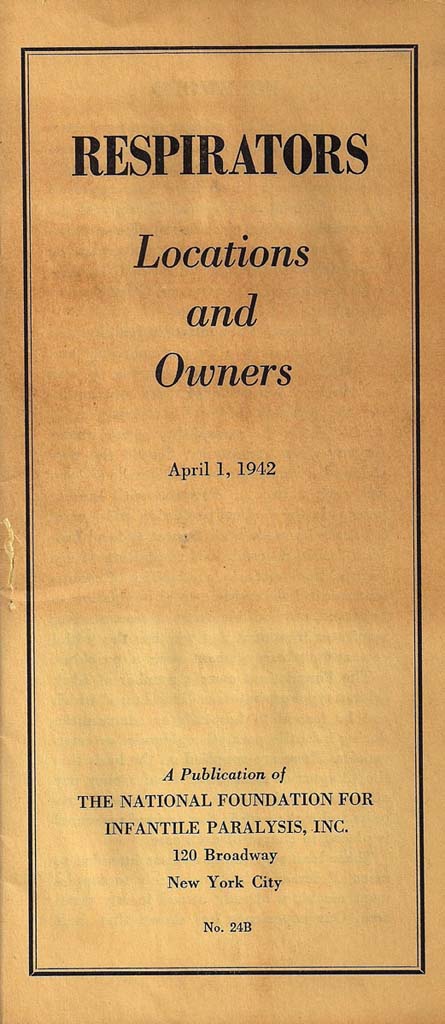
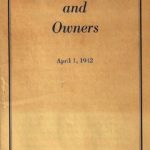
1942 Directory of Respirator Resources
Resources for construction of new negative pressure respirators became scarce as World War II escalated. In 1942, the National Foundation for Infantile Paralysis published a directory identifying the names and locations of facilities with "iron lung" respirators.
Image from Steve and Mary DeGenaro
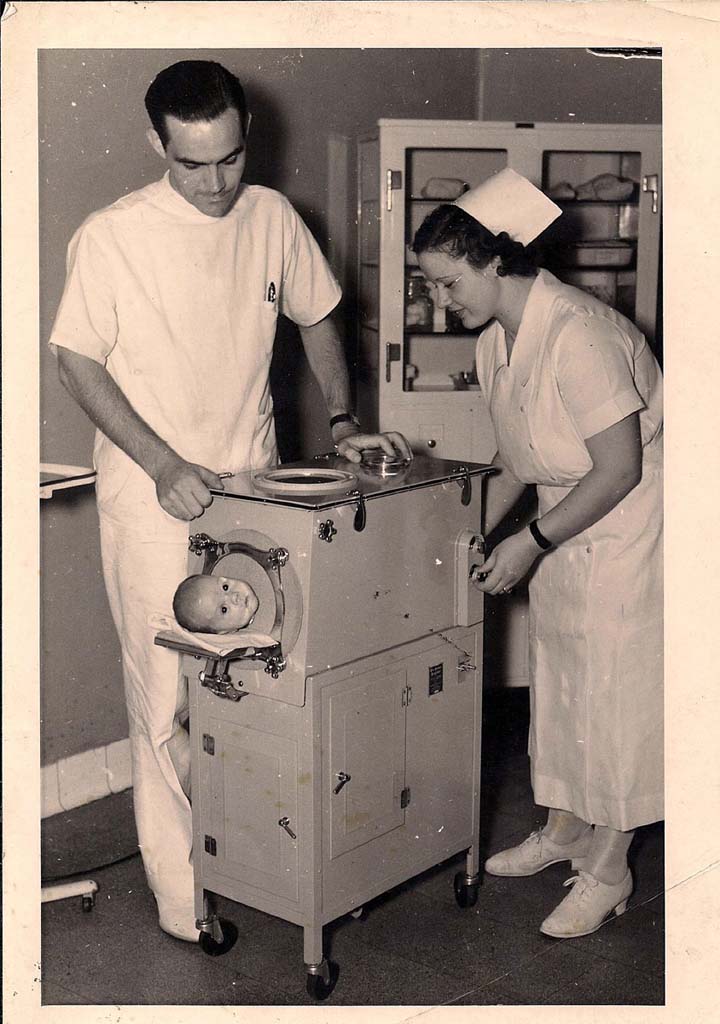
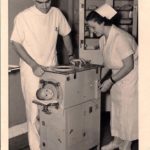
1940s Pediatric Iron Lung
This image show caretakers with an infant in a small "iron lung."
Image from Steve & Mary DeGenaro
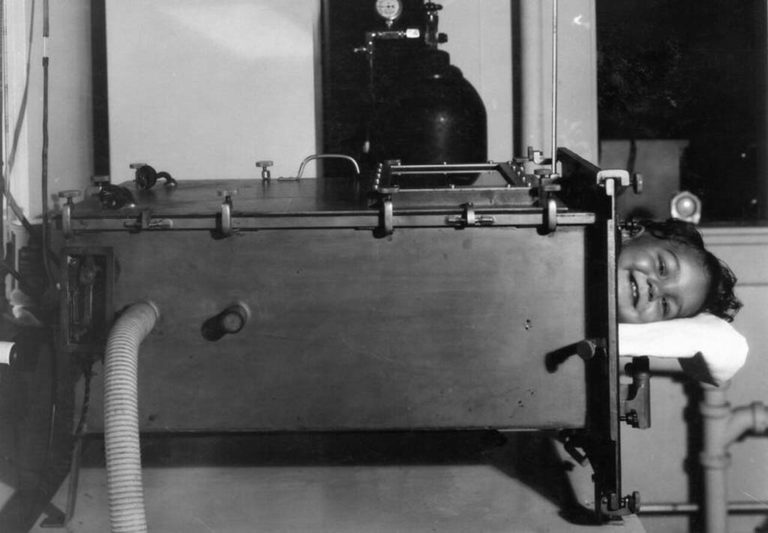
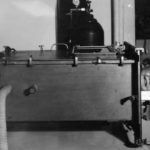
Pediatric Iron Lung
An "iron lung" designed for pediatric patients is shown.
Image provided from Boston Children's Hospital Archives
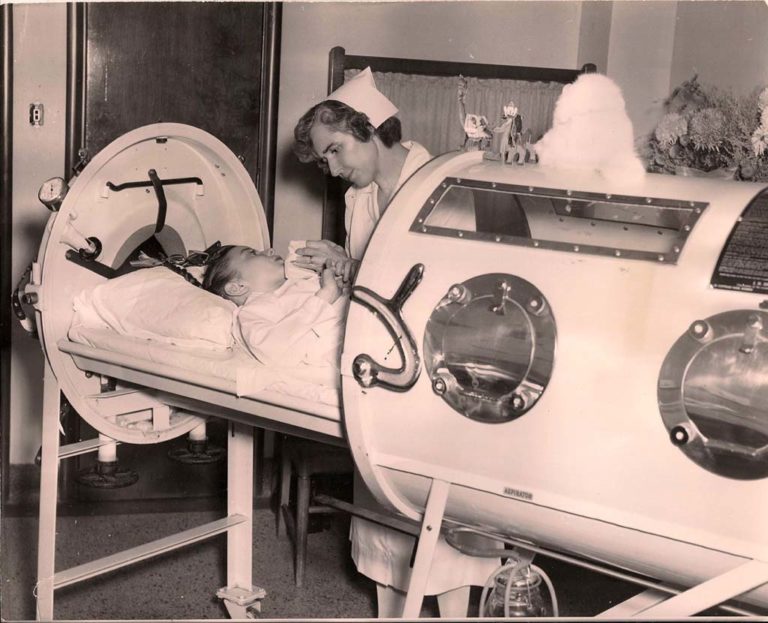
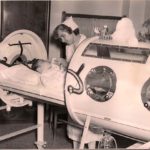
1940s
The chamber of the "iron lung" could be opened to provide nursing care.
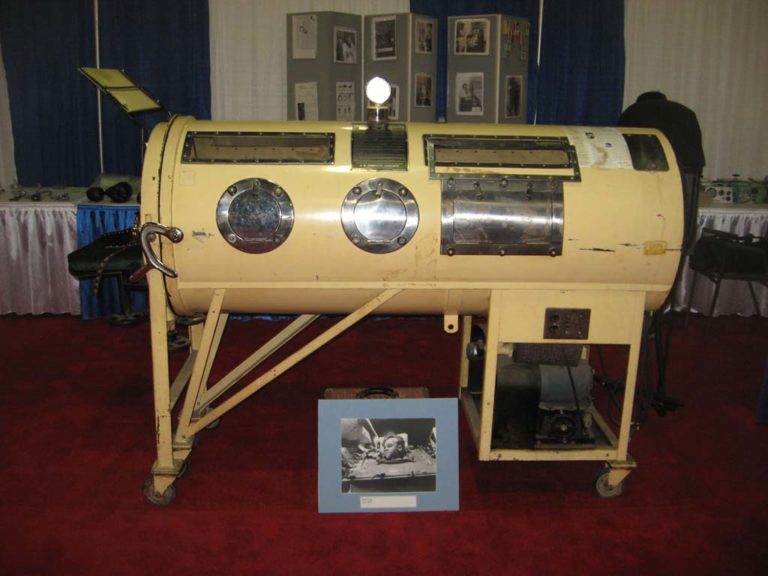
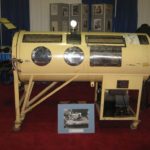
1940s Emerson Iron Lung
The early Emerson "iron lung" models were painted blue, later models were yellow.
Image from James Sullivan
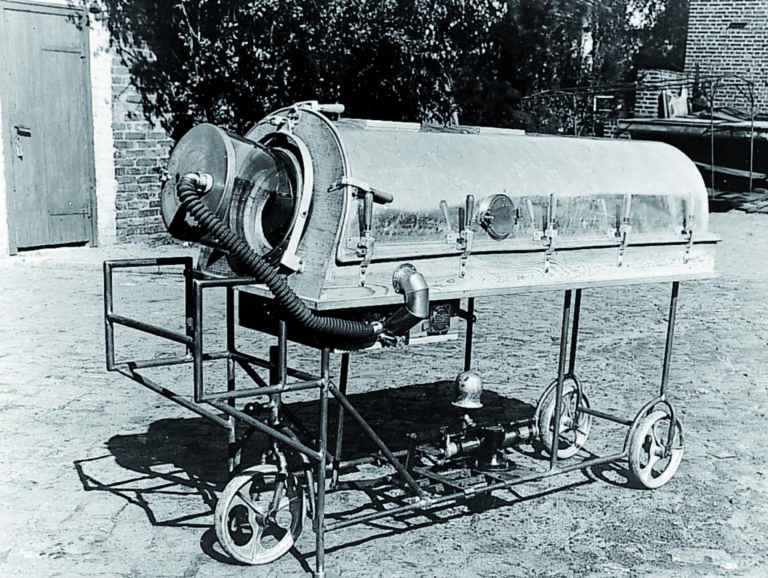
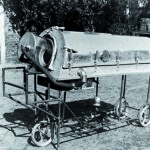
Dräger Iron Lung Prototype
The prototype of the Dräger "Iron Lung" with a torpedo tube frame is shown. By 1947, the company was producing "iron lung" ventilators constructed from scrap metal left over from World War II.
Image from Dräger
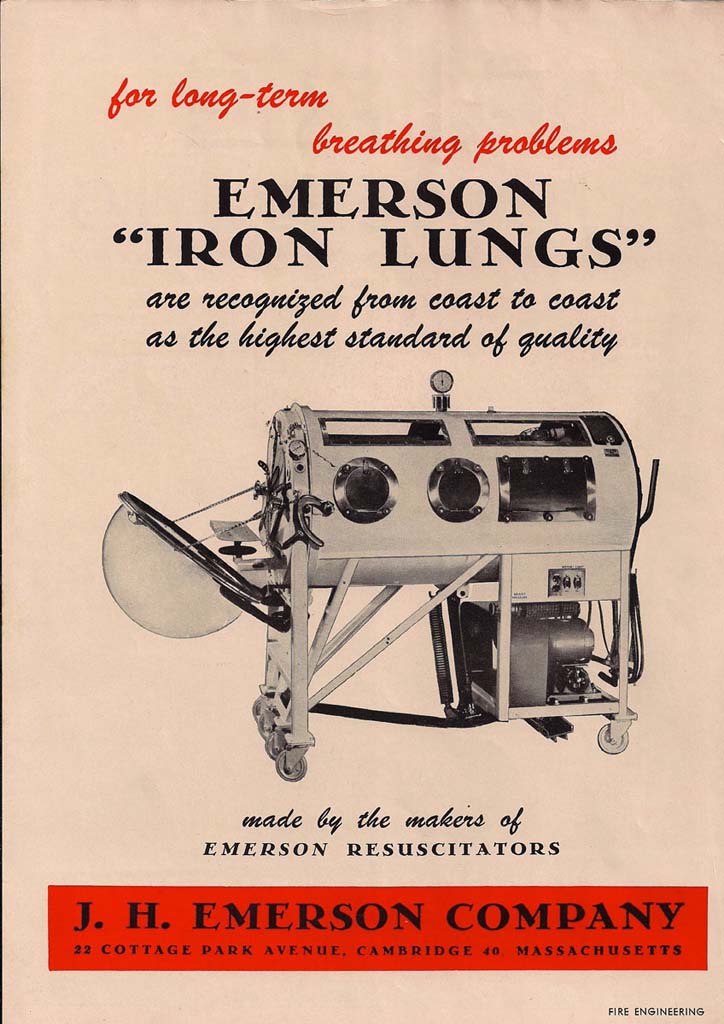
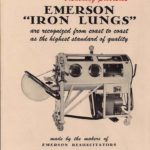
1947 Emerson "Iron Lung"
An ad for the 1947 Emerson "Iron Lung" model is shown.
Image from Steve & Mary DeGenaro
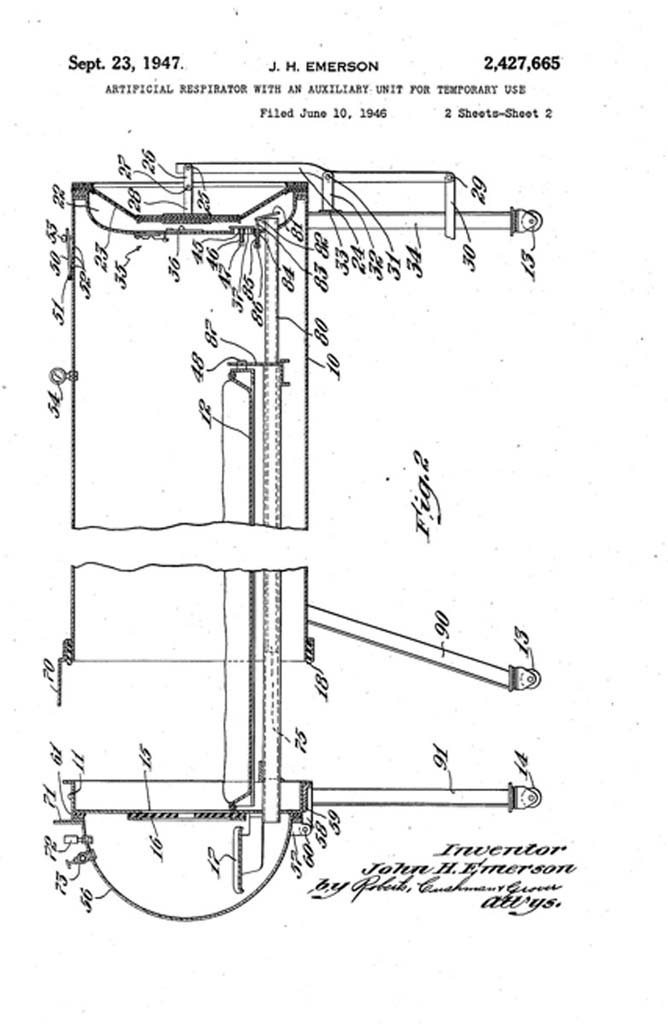
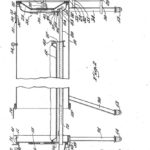
1947 J.H. Emerson's Dome Patent
J.H. Emerson received a patent in 1947 for an enclosure that fit over the patient’s head delivered intermittent positive pressure in the dome when the body chamber was opened for routine care and therapy.
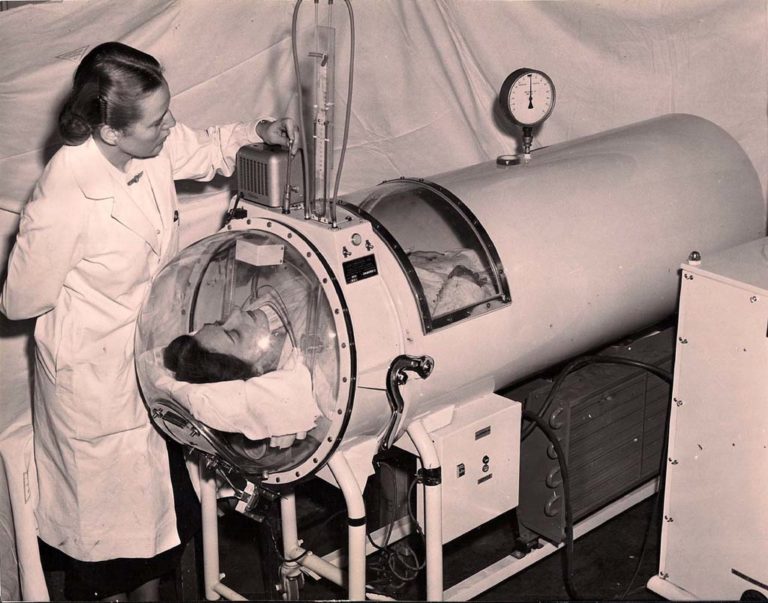
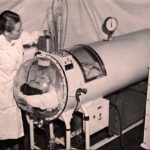
Late 1940s Iron Lung with Dome
The domed head chamber on an "iron lung" is shown in this 1940s photo.
Image from Steve & Mary DeGenaro
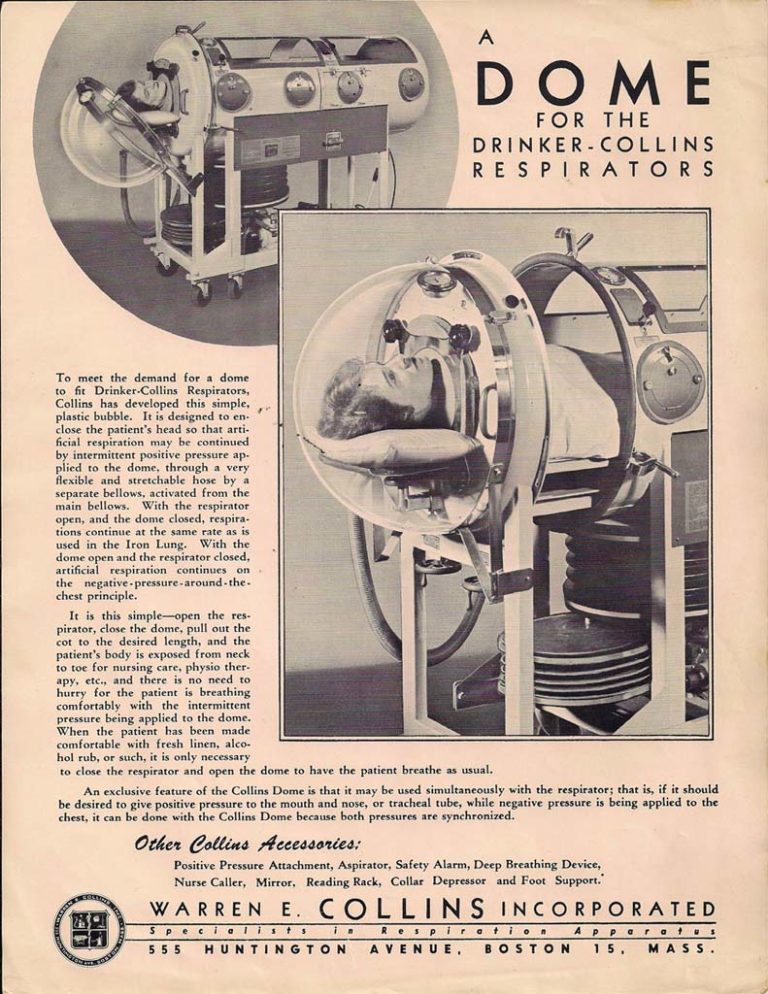
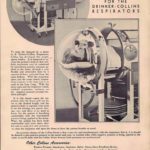
1950s Dome for Drinker-Collins Respirators
In the 1950s, the Drinker-Collins "iron lung" offered a clear, domed head chamber as well as clear sections of the body chamber.
Image from Steve & Mary DeGenaro
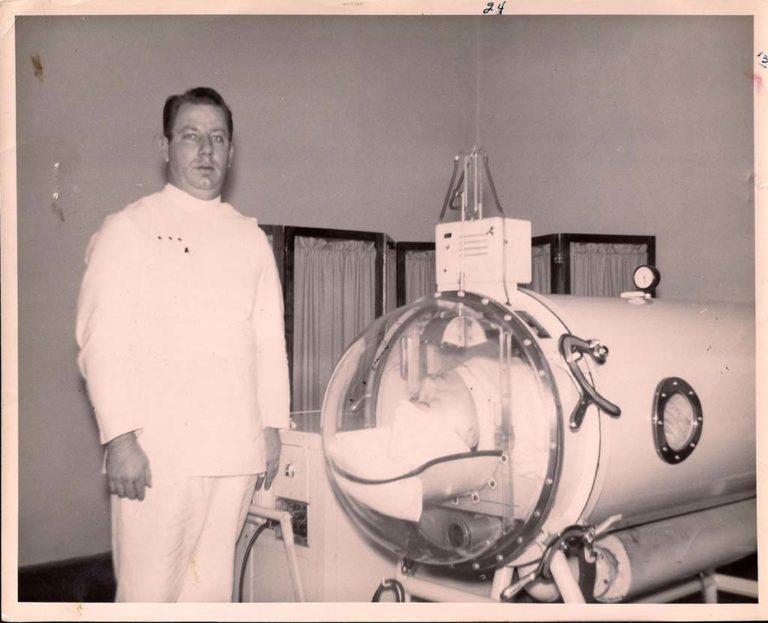
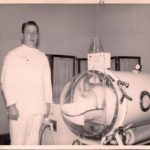
1950s Dome
A caretaker is shown next to an adult patient in a domed, "iron lung."
Image from Steve & Mary DeGenaro
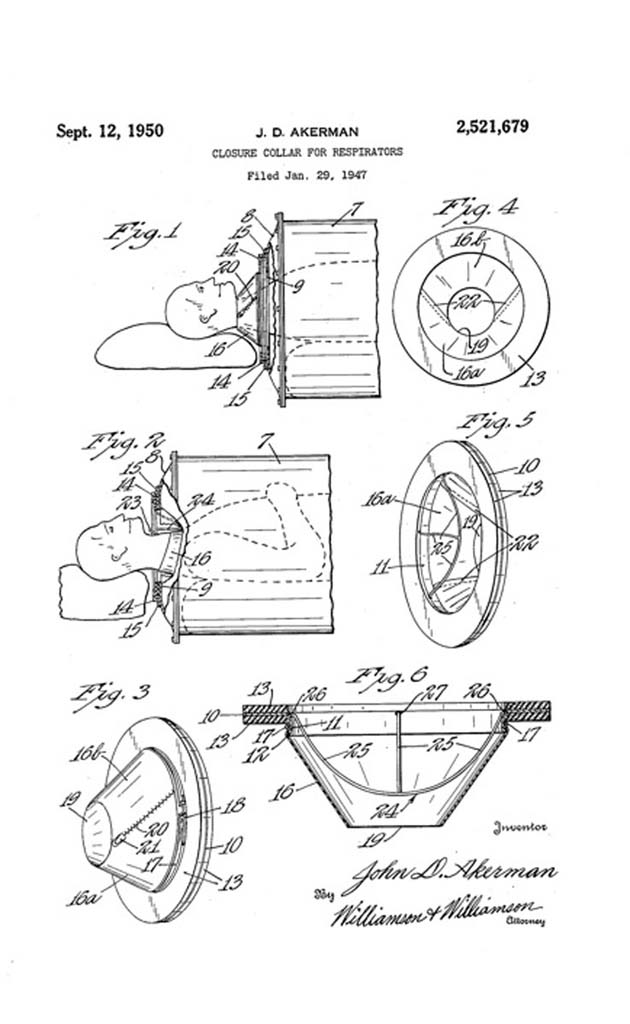
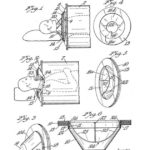
1950 Patent for Lung Collar
In 1947, J.D. Akerman filed a patent application for a closure collar for the negative pressure respirators. The patent was granted in 1950.
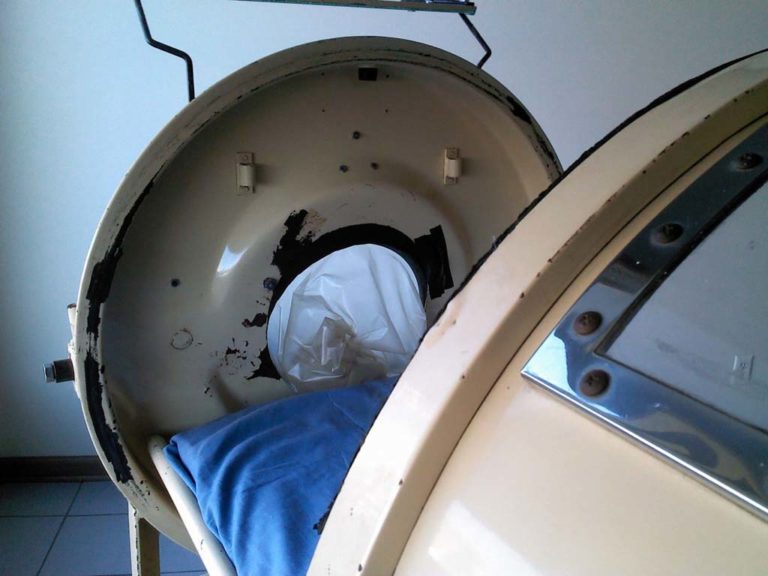
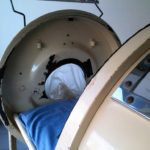
View of a Neck Collar
View of a neck collar from inside an "iron lung."
Image from Colleen Schabacker
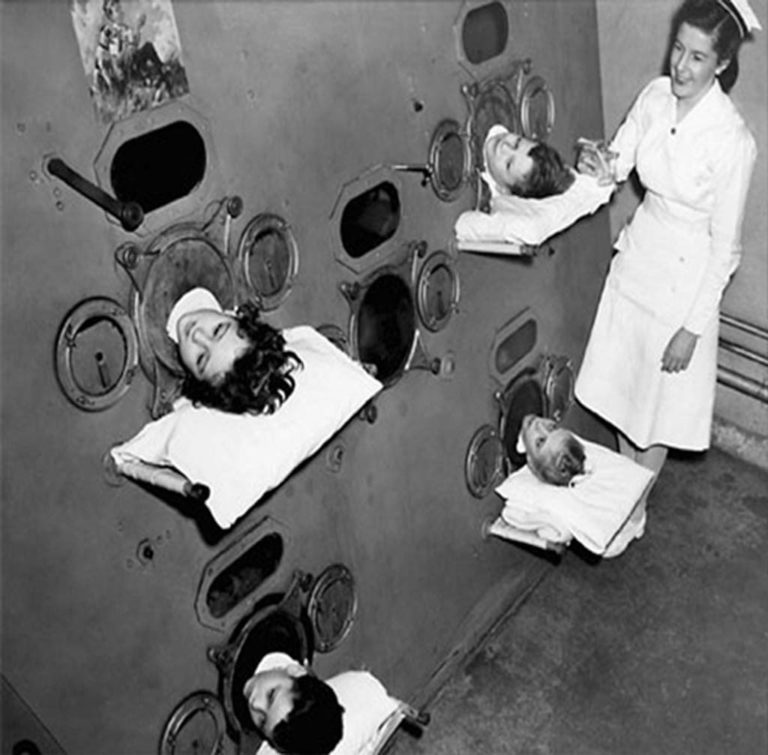
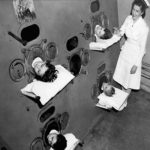
1950s Multi-Person Ventilator
In the 1950s, Dr. James Wilson developed a multi-person negative pressure ventilator at Boston Children’s Hospital.
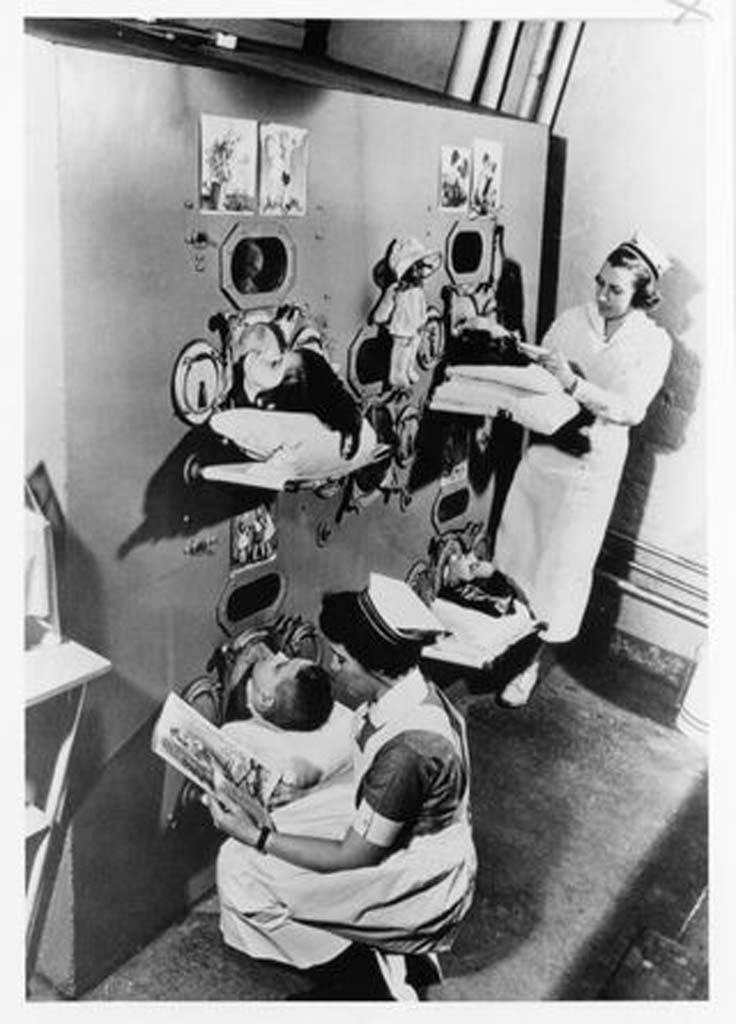
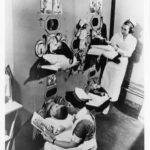
Four Person Chamber
A unit that could house up to 4 four patients requiring negative pressure ventilation at the same time was offered at Boston Children's Hospital in the 1950s.
Image from the archives of Children's Hospital of Boston
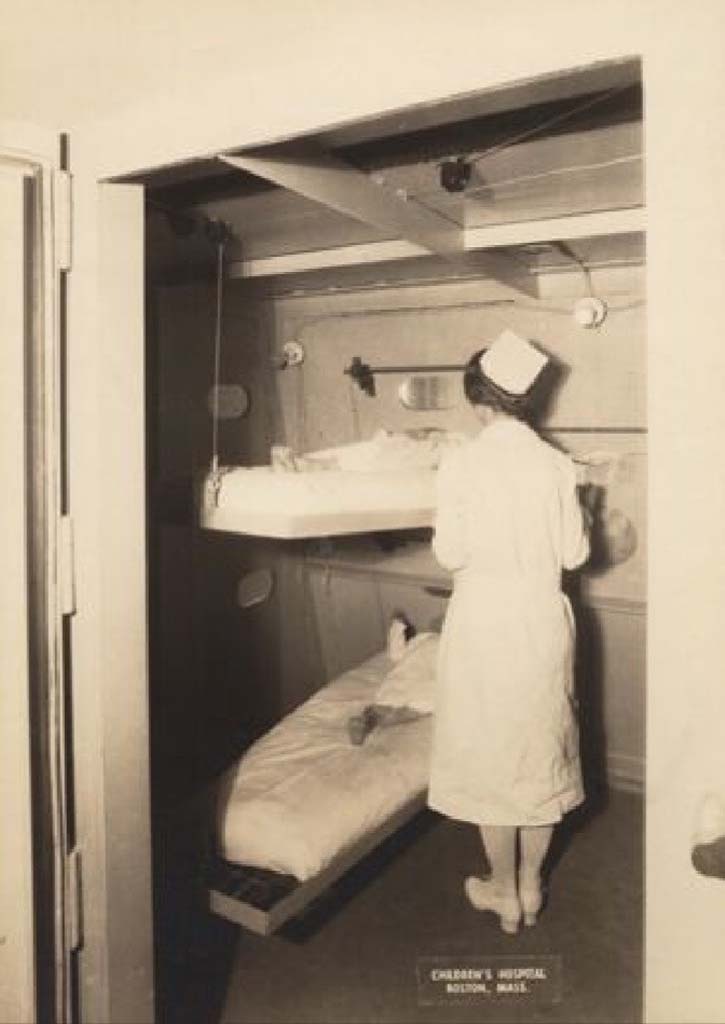
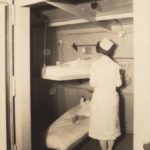
Interior View of Chamber
The interior of the 4 person "iron lung" chamber is shown.
Image from the archives of Children's Hospital of Boston
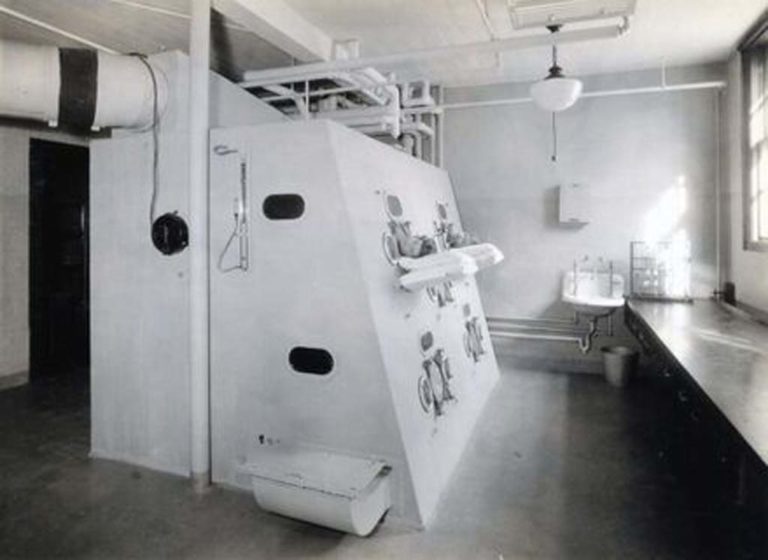
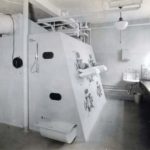
4 Person Ventilator
This unit allowed four persons to be housed in one large negative pressure ventilation chamber. The device was located at Boston Children's Hospital.
Image from the archives of the Children's Hospital of Boston
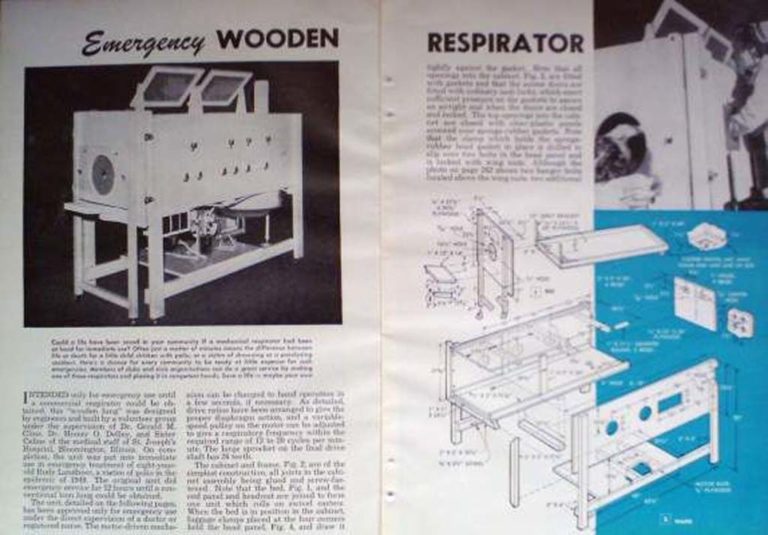
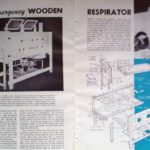
1952 DIY Emergency Wooden Respirator
The last major polio epidemic peaked in the United States in 1952. Due to the scarcity of available “iron lungs” around the country, a well-known magazine for “do-it-yourselfers” published blueprints for construction of an emergency wooden respirator.
Image from Glenn Tammen
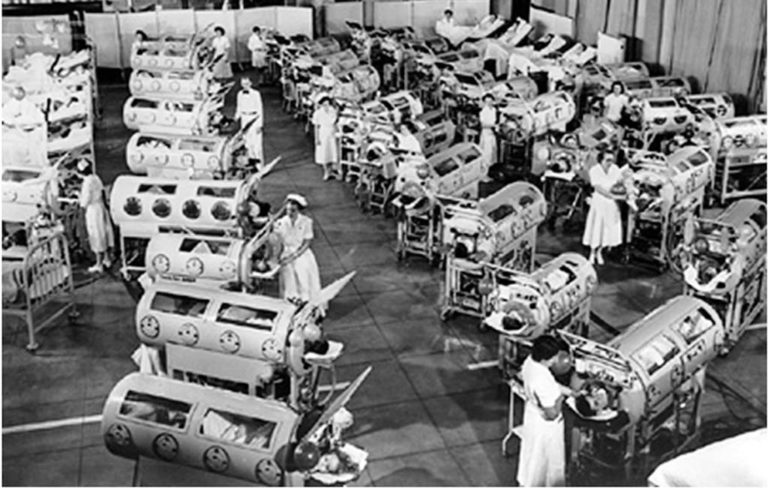
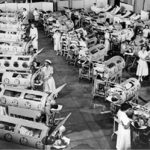
1953 Poliomyelitis Epidemic Patients
Because "iron lungs" were mostly available in large cities, family from small cities or rural areas often had to travel long distances to visit their family member in a hospital that had "iron lungs" available. The polio epidemic had just peaked when this photo was taken at Rancho Los Amigos Hospital in Downey, California.
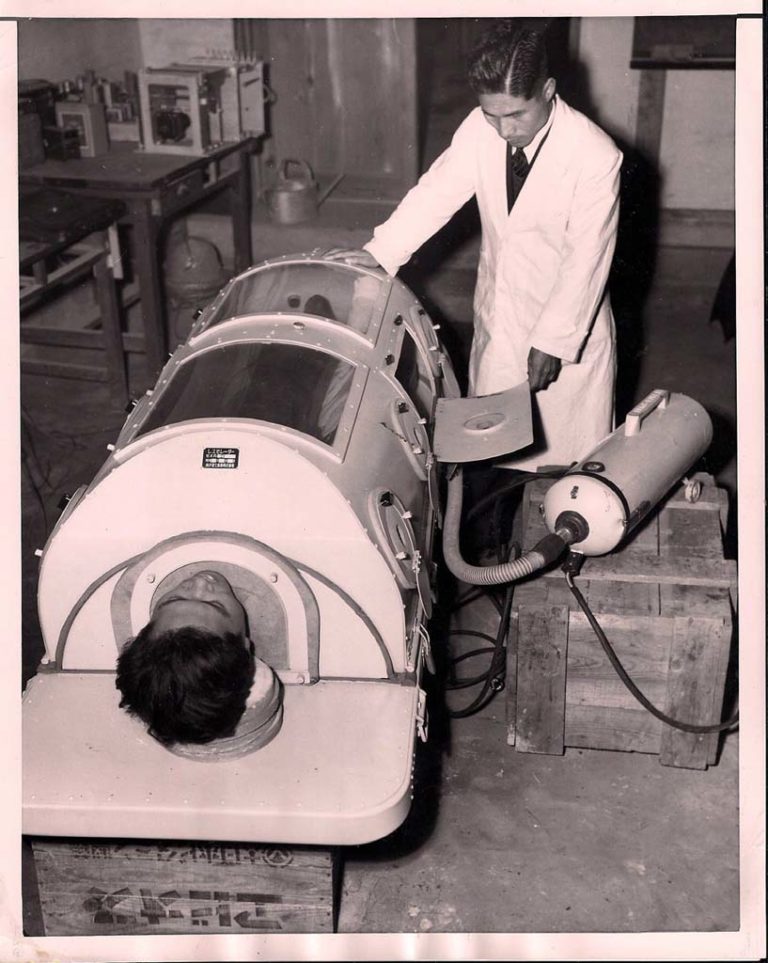
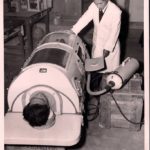
1953 Duralmin Lung from Japan
This 1953 photo shows Professor Hideo Itokawa opening the door of his duralmin lung, which reportedly was produced at one-third the price of similar models available in the United States.
Image from Steve & Mary DeGenaro
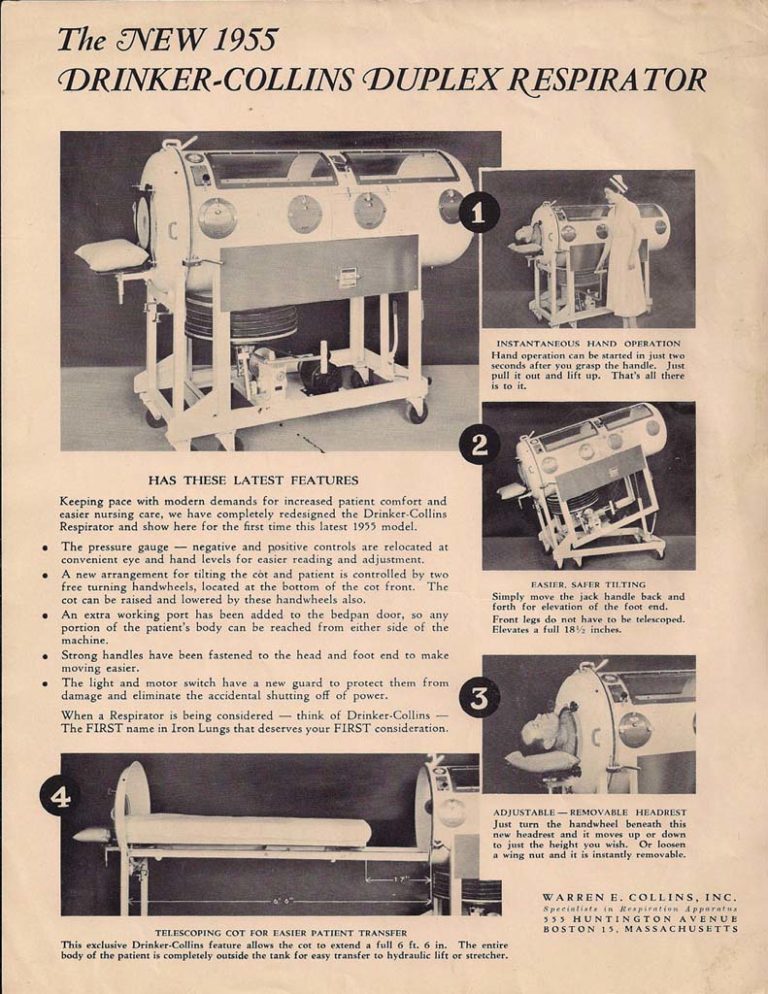
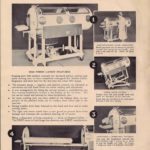
1955 Drinker-Collins Duplex Respirator
The 1955 model respirator ad indicated that it offered options for enhanced patient comfort and ease of nursing care.
Image from Steve & Mary DeGenaro
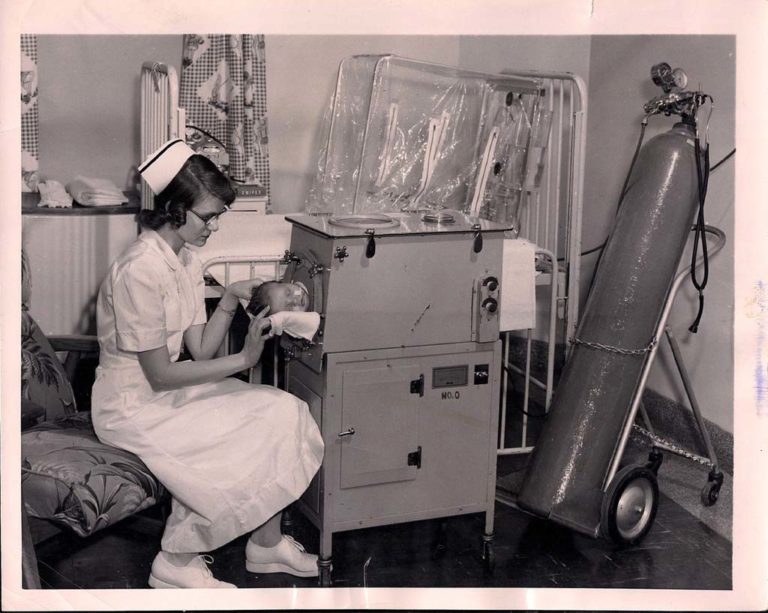
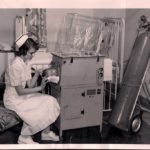
1950s Infant Iron Lung
An infant is shown in a small "iron lung". A pediatric oxygen tent is shown on the adjacent crib.
Image from Steve & Mary DeGenaro
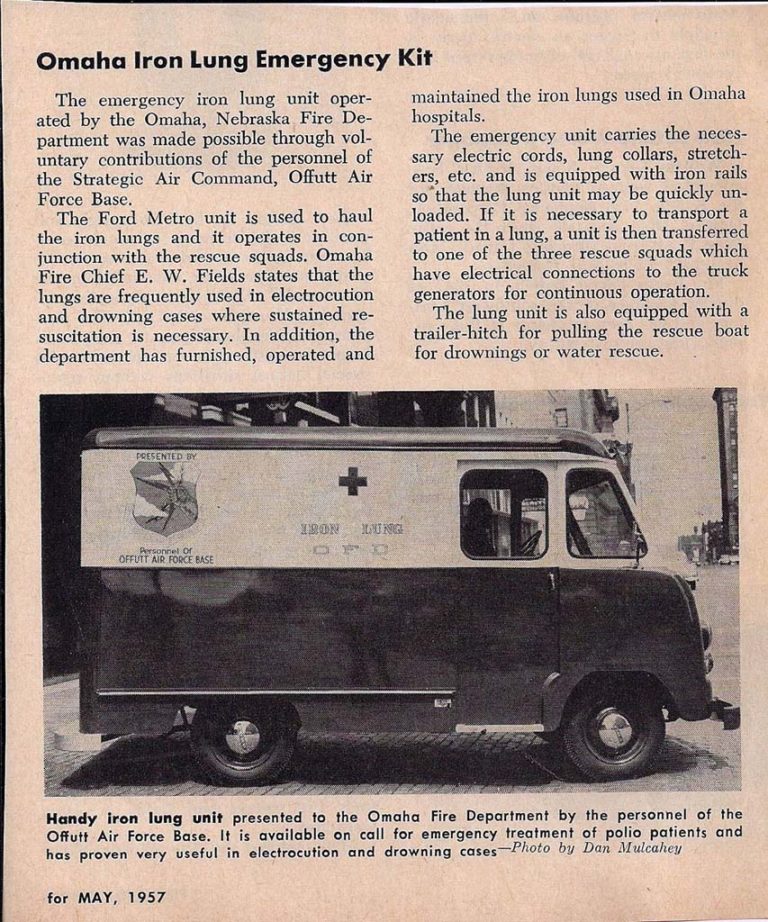
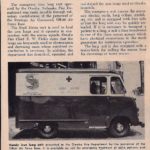
1957 Mobile "Iron Lung" Ambulance
In this May 1957 article, the emergency mobile "iron lung" ambulance of the Omaha, Nebraska Fire Department was featured.
Image from Steve & Mary DeGenaro
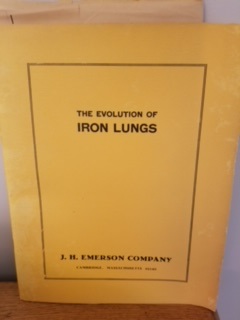
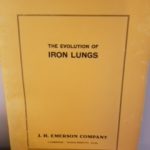
History of Iron Lungs
The booklet, "The Evolution of Iron Lungs", was published in 1958 by the J. H. Emerson Company. Many images from the booklet are included within this gallery.
Image from Lynda Goodfellow
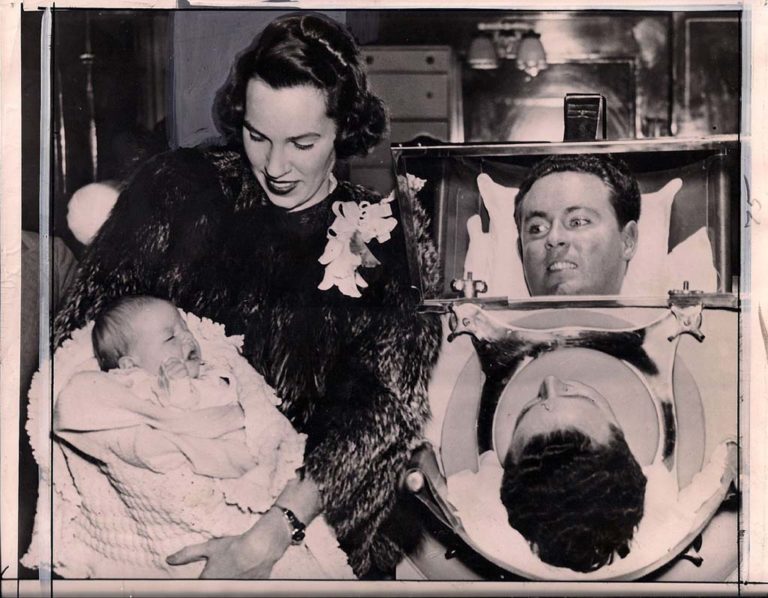
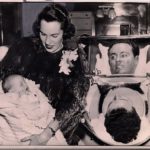
1950s
A series of newspaper articles featured this family during the polio epidemic. The father contracted polio prior to the birth of the baby. The mirror mounted above the head allowed the patient's visitors to readily view the patient's face.
Image from Steve and Mary DeGenaro
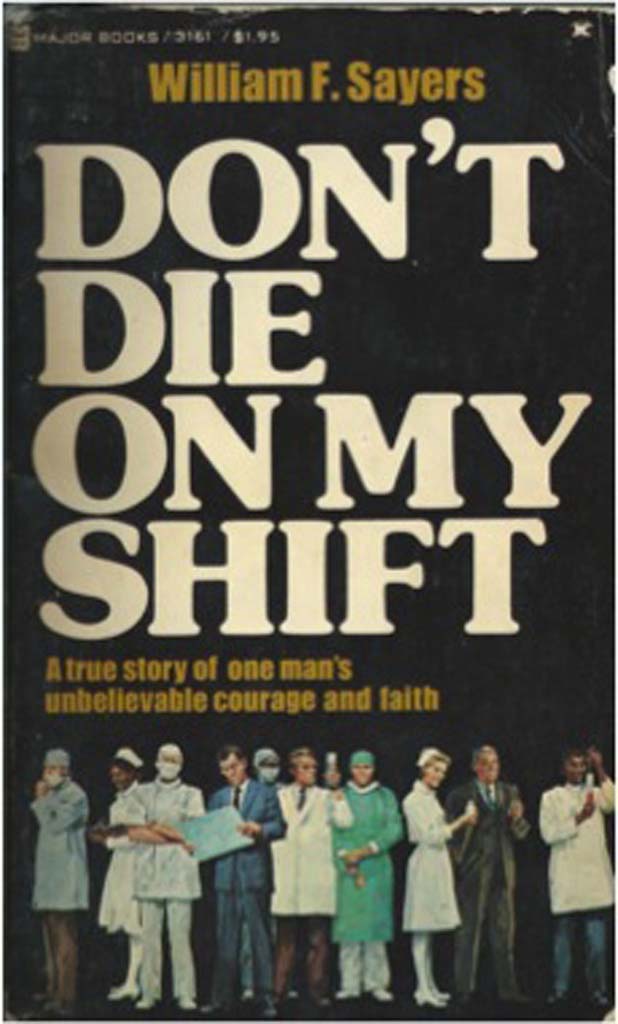
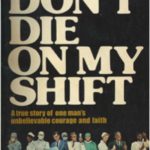
1977 Don't Die On My Shift Published
This non-fiction book chronicles the life of the author from the time of his initial bout with polio in 1952 through 1968. The book covers his life in an iron-lung in a hospital ward through his eventual discharge home receiving mechanical ventilation through a mouthpiece.
Don't Die On My Shift by William F. Sayers, published by Major books, July 1977. ISBN # 0-89041-161-1.
Don't Die On My Shift by William F. Sayers, published by Major books, July 1977. ISBN # 0-89041-161-1.
Image from Gayle Carr


Portable Respirators
Portable negative pressure respirators are featured in this section of the gallery.
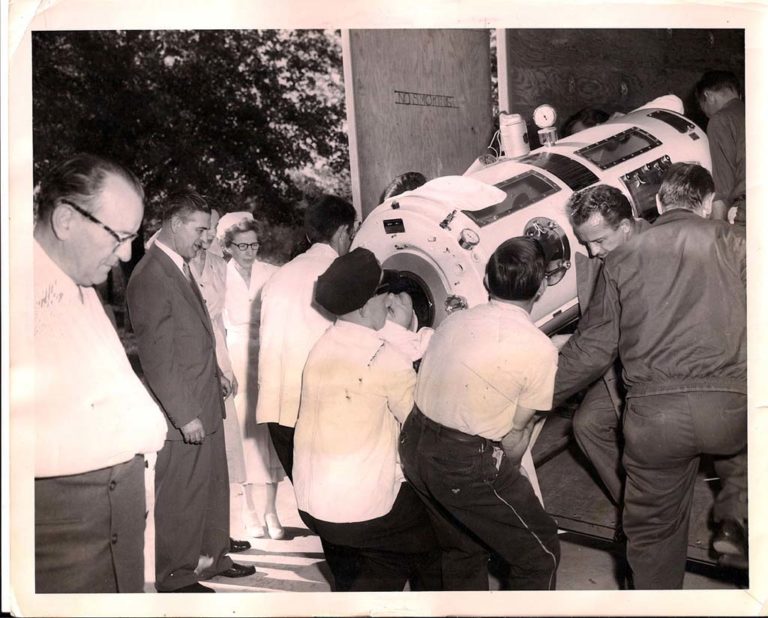
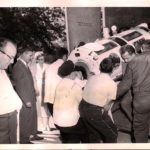
1953 Transport in an "Iron Lung"
In this November 5, 1953 photo, Lauren Carlson, age 24, was being transported in an "iron lung" to a specialized care center, the Sister Kenny Unit at the Oakland County Contagious Hospital in Farmington, Michigan. Depending on the model, "iron lungs" weighed between 1,000-1,800 pounds.
Image from Steve & Mary DeGenaro
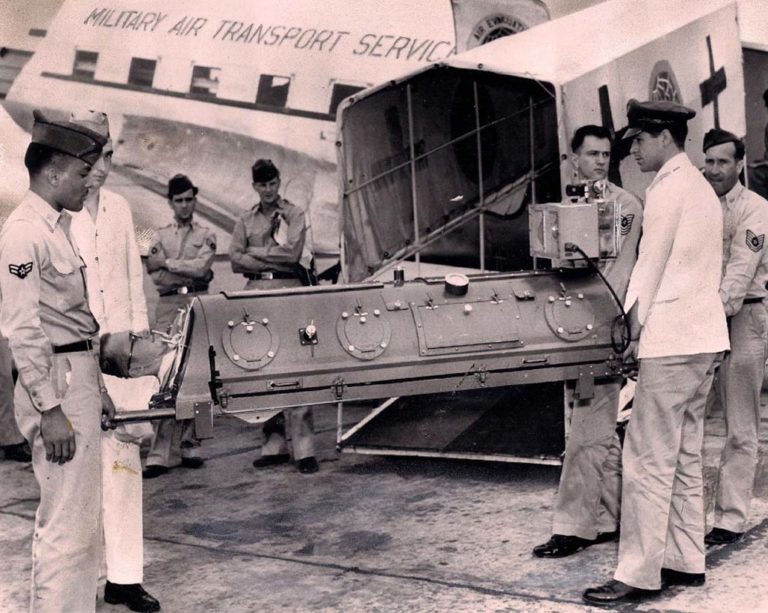
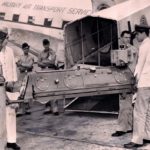
1953 Lightweight Unit for Military Transport
In July 1953, the military began using a lightweight unit made of aluminum alloy and plastic. The unit weighed only 150 pounds, approximately 1/10 the weight of standard iron lungs. In this photo, a soldier who contracted polio was being airlifted from Walter Reed Hospital to a Michigan hospital closer to his home.

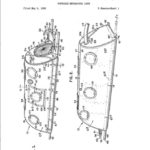
1957 Haverland's Patent
In 1957, William H. Haverland was granted a patent for the lightweight, “portable mechanical lung”.
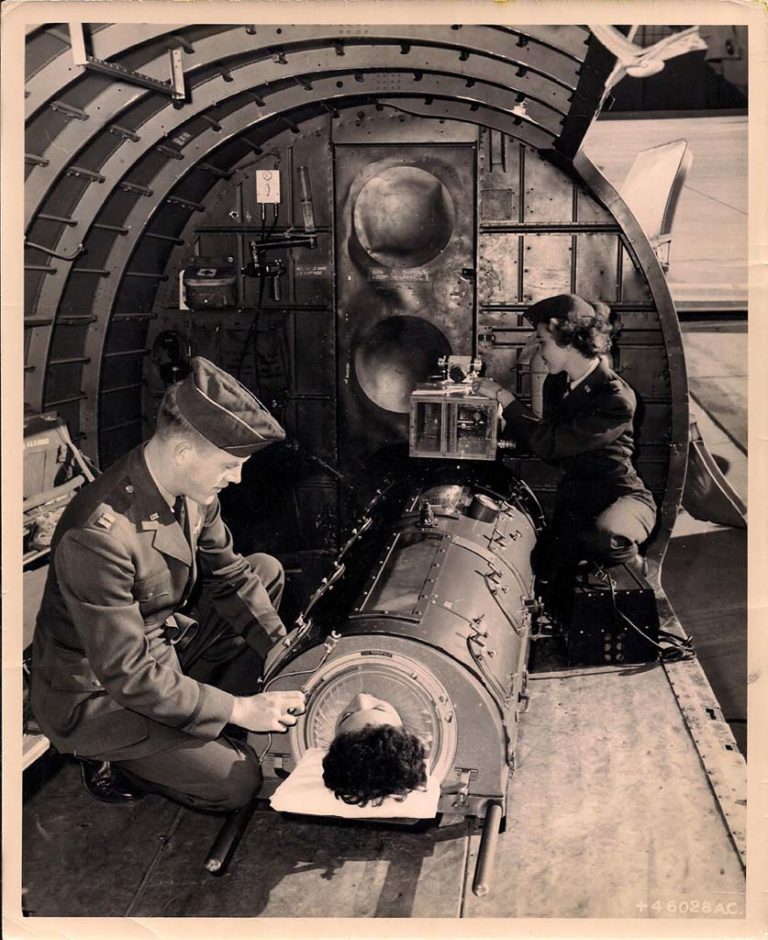
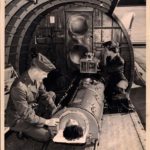
1950s Military Transport
A portable "iron lung" is shown in this transport by the military.
Image from Steve & Mary DeGenaro
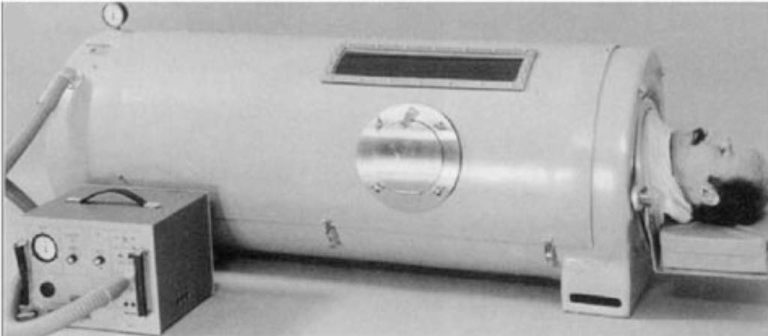
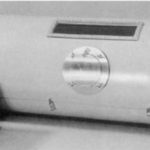
Early PortaLung
An early PortaLung is shown.
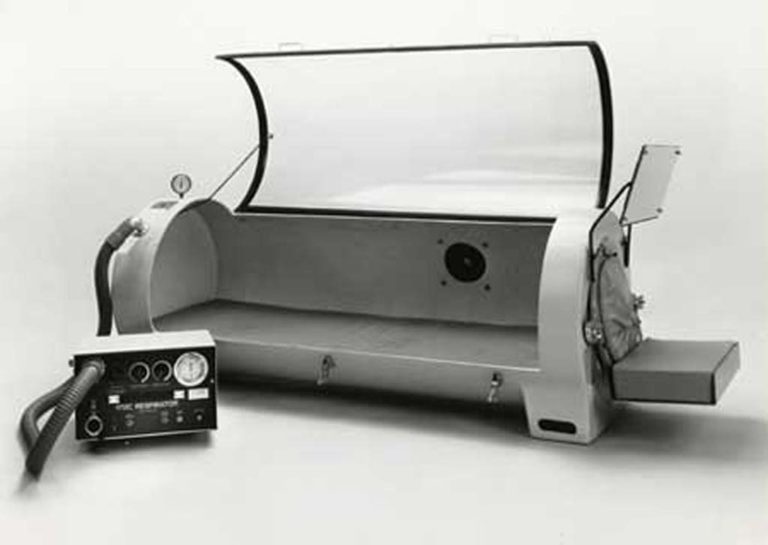
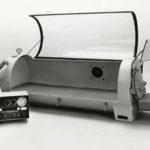
Early Model of Portable Respirator
An early model of a portable "iron lung" is shown in the open position.
Image from Mark Anderson
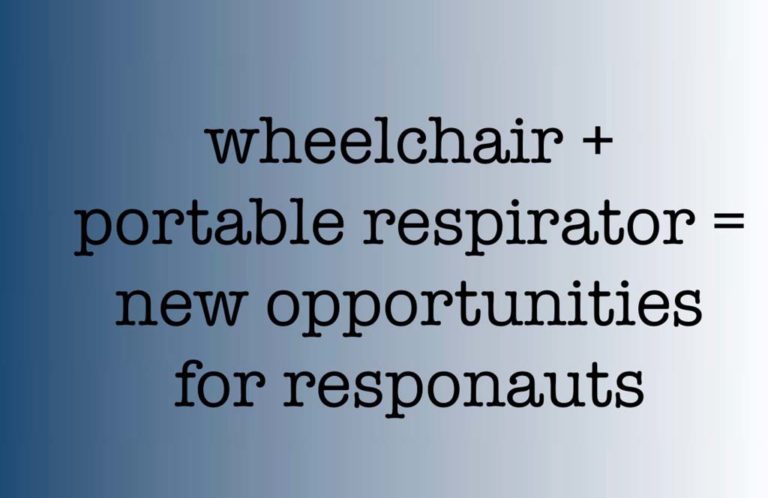
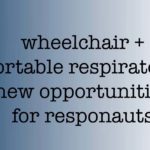
Opportunites for Responauts
Responaut is a term coined to describe an individual permanently dependent on mechanical ventilation.
When Robin Cavendish of England contracted polio at age 28, he enlisted the assistance of Professor E. Teddy Hall to help him design a ventilator built into a wheelchair to allow mobility for himself and fellow "responauts", those individuals who were previously confined to iron lungs or ventilators in the hospital setting. The first prototype of the ventilator-wheelchair was released circa 1962. Cavendish developed other devices to improve the quality of life for others with disabilities and actively advocated for those with neurological and neuromuscular impairments until his death in 1994.
When Robin Cavendish of England contracted polio at age 28, he enlisted the assistance of Professor E. Teddy Hall to help him design a ventilator built into a wheelchair to allow mobility for himself and fellow "responauts", those individuals who were previously confined to iron lungs or ventilators in the hospital setting. The first prototype of the ventilator-wheelchair was released circa 1962. Cavendish developed other devices to improve the quality of life for others with disabilities and actively advocated for those with neurological and neuromuscular impairments until his death in 1994.


Pneumowraps & Pneumobelts
Pneumobelts and pneumowraps are featured in this section of the gallery.
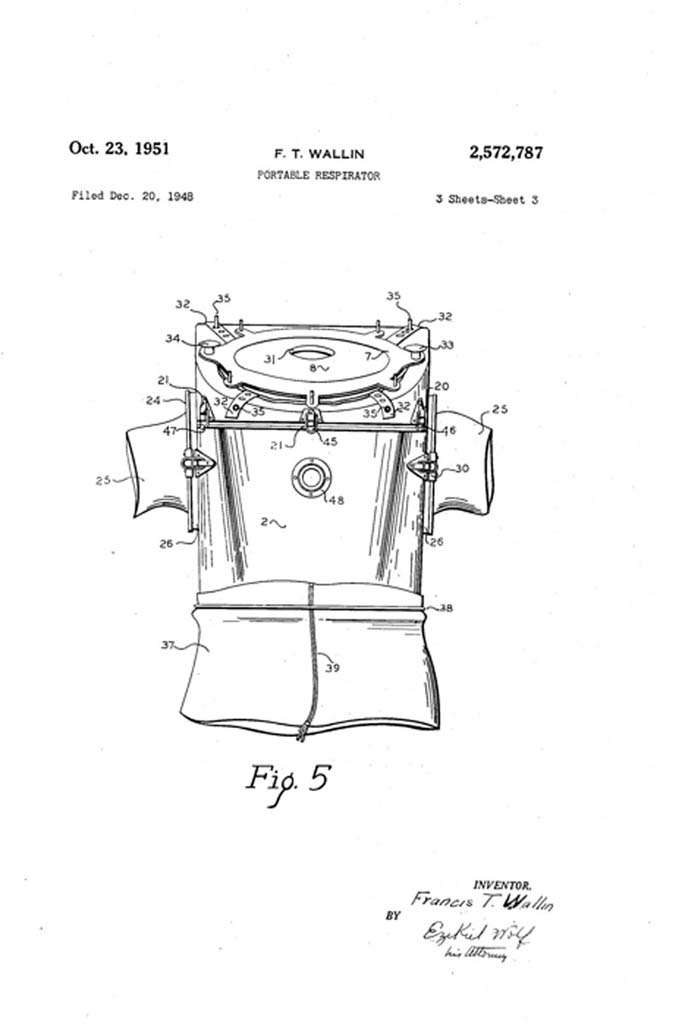
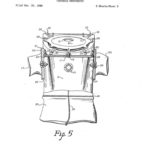
1948 F.T. Wallin Patent Filed
In 1948, Francis Wallin filed an application for a “portable respirator” which included a garment and shell combination. The patent was awarded in 1948.
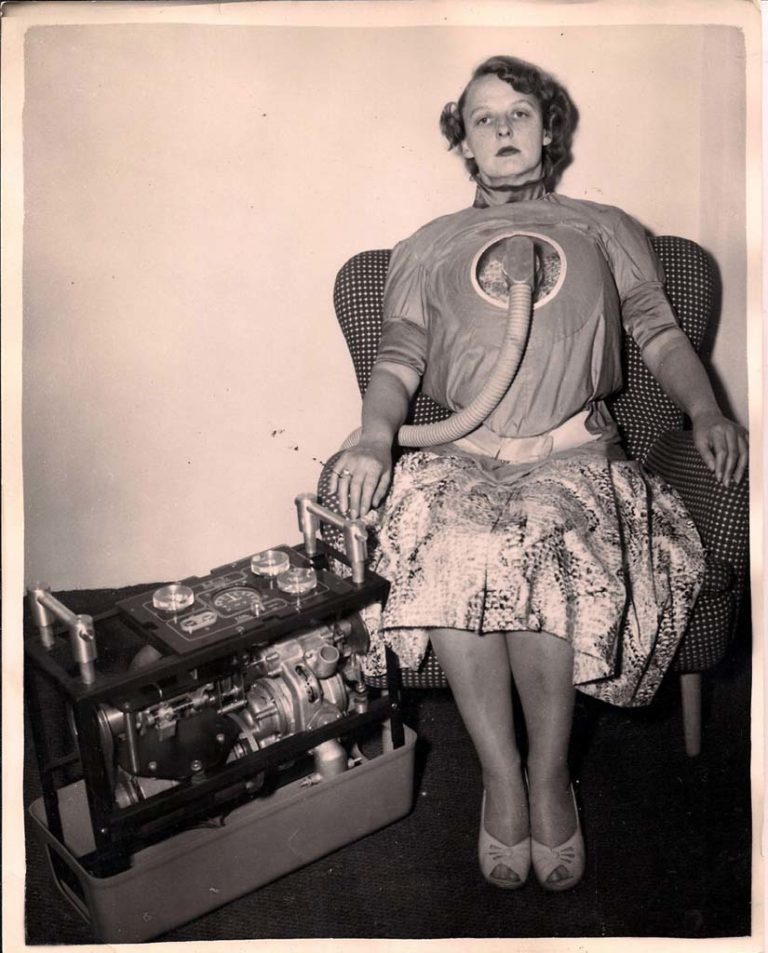
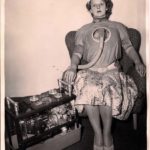
Late 1940s Cuirass Shirt
In order to increase effectiveness, in some cases the cuirass was applied to the chest, and an air-tight garment was placed over the cuirass to make a seal. Garments such as ponchos and rain suits that were tight fitting at the waist, neck, and arms helped achieve an air-tight seal for effective ventilation.
Image from Steve & Mary DeGenaro

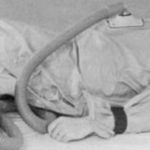
Mid-1950s PneumoWrap
A pneumowrap attached to a ventilator is shown in this 1950s photo.
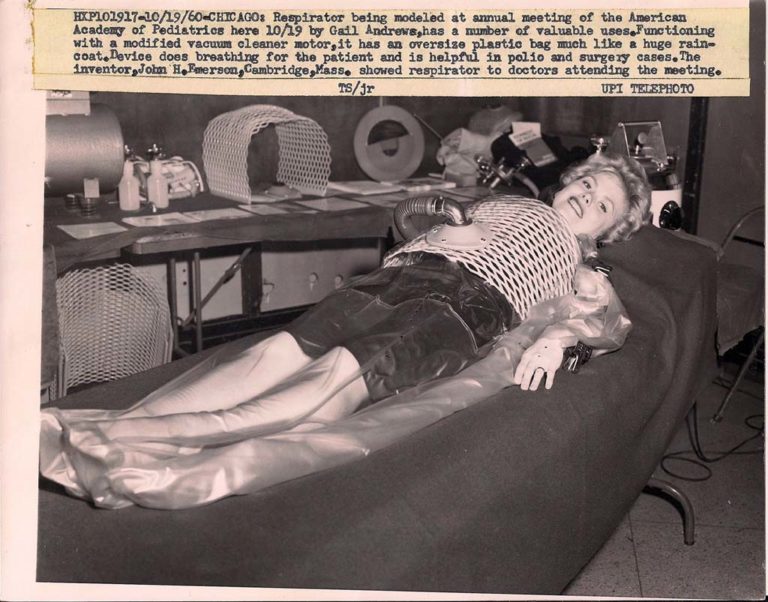
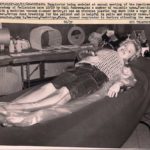
1960 Emerson Raincoat
A rigid case is placed over the thorax and the patient is enclosed in an airtight plastic garment such as a poncho or rain suit. An electric motor that cycles on and off is used to create suction pressure to the airtight enclosure. This negative pressure is applied to the thorax and generates chest expansion. To be effective the system must be airtight. Although less cumbersome than an iron lung, it still was confining and restricting for the patient.
Image from Steve & Mary DeGenaro
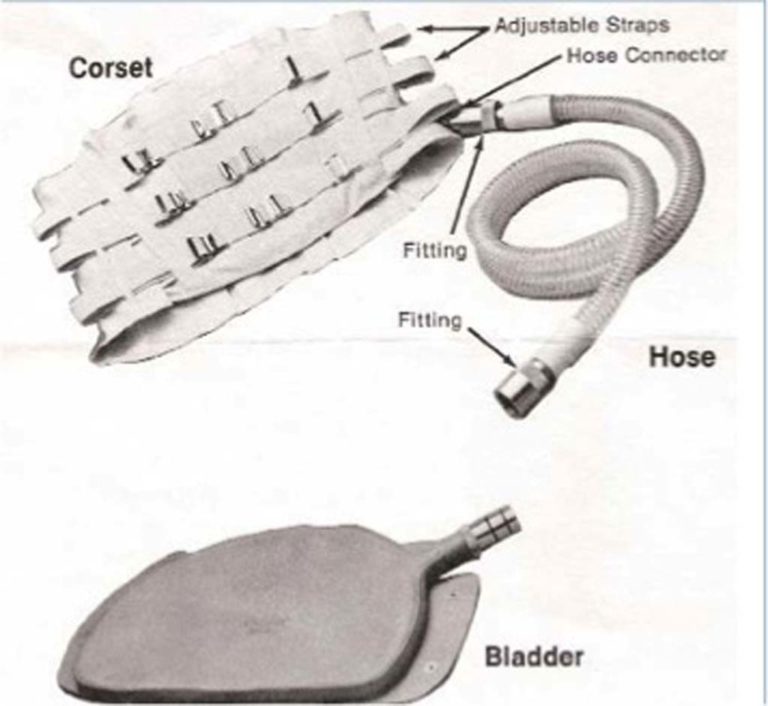
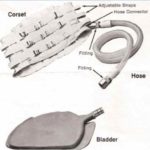
1958 Pneumobelt
The Pneumobelt was introduced in 1958 and is alternatively known as an intermittent abdominal pressure ventilator (IAPV). It consists of an inflatable bladder that is secured over the abdomen. The patient must be seated to use the device. An electrically powered motor sends air to the bladder intermittently which expands the bladder. When the bladder inflates, it compresses the patient’s abdomen and forces the diaphragm to move upwards, aiding expiration. Inspiration is relatively passive as the bladder deflates, the diaphragm moves downward by gravity.
Trademark filed 1958 by Thompson Corp.
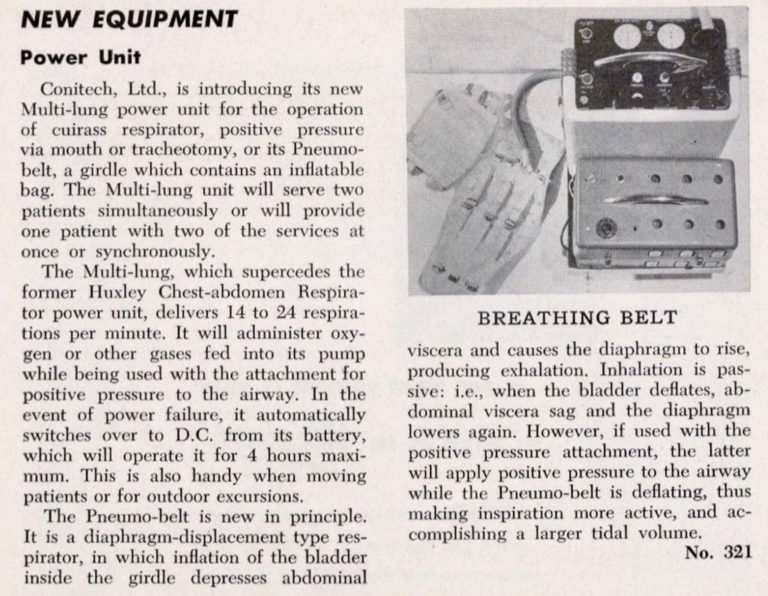
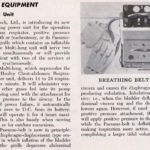
Pneumo-belt
This ad, which introduced the Conitech Multi-lung power unit for cuirass and the new Pneumo-belt, appeared in the June 1958 issue of the INHALATION THERAPY journal.
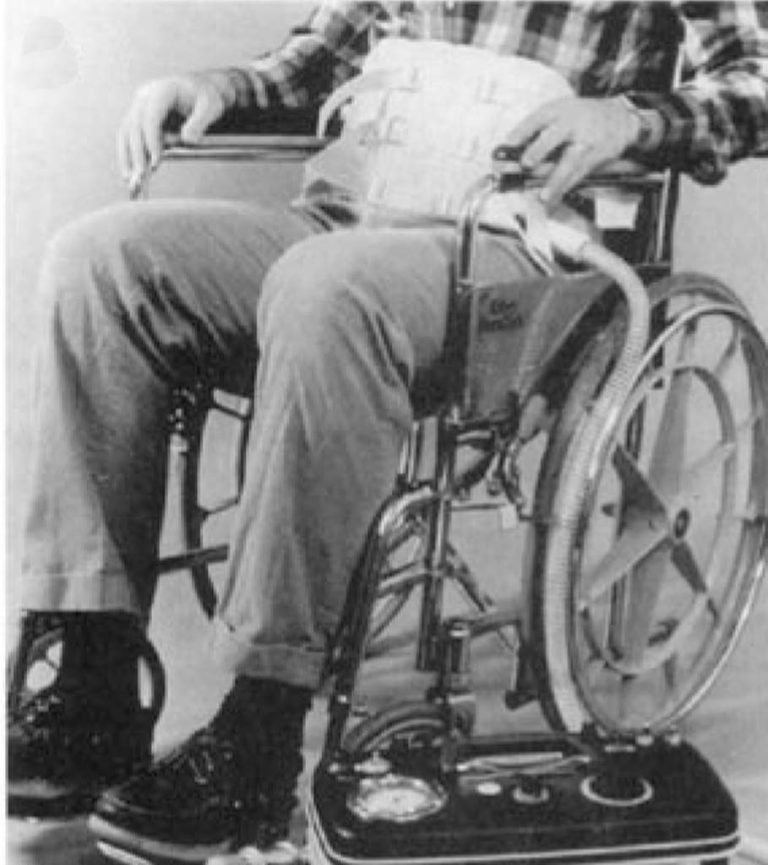
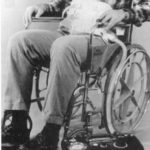
Pneumo-belt
A Pneumo-belt and a Thompson ventilator mounted in a popular 1950s luggage case) is shown.


Cuirass
Like the iron lung, an electric motor was used to generate negative pressure. In this case the pressure was directed only to the patient’s chest, unlike the iron lung, where negative pressure was delivered to the entire body enclosed in the iron lung chamber. The motor was set to cycle and deliver negative pressure intermittently to achieve a respiratory rate. Negative pressure applied to the chest wall allowed for chest expansion and thus generated an inspiration. To be effective an air-tight seal was necessary. When the motor cycled off, the relief of negative pressure allowed for a passive expiration. Although current use is limited, there is some application for the chest cuirass particularly in neuromuscular patients and those patients with relatively normal compliance and airway resistance. The chest cuirass offers the advantage that ventilation is non-invasive and unless another indication is present, intubation or tracheostomy are unnecessary to deliver ventilation. Current models have active inspiration and expiration phases, and modern technology allows for molded plastics to be used for custom fitting of a cuirass to an individual patient’s chest configuration.
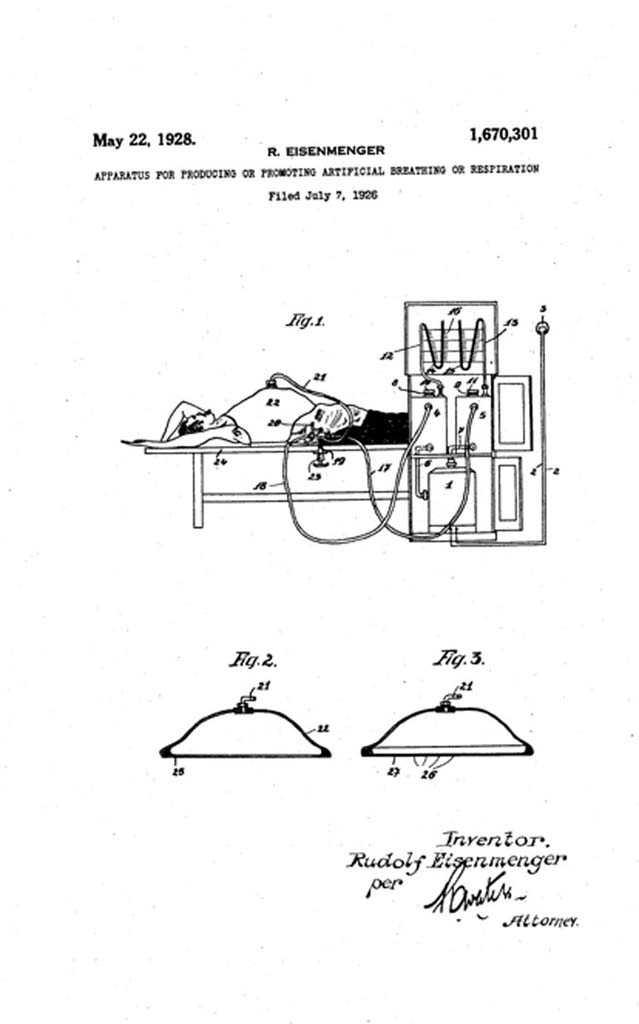
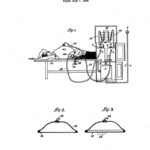
1928 Eisenmenger's Patent
Beginning in 1920, Rudolf Eisenmenger began applying for patents in Europe for his “apparatus for producing or promoting breathing or respiration.” He applied for a patent for the device in the USA in July 1926 and was granted the patent in May 1928.
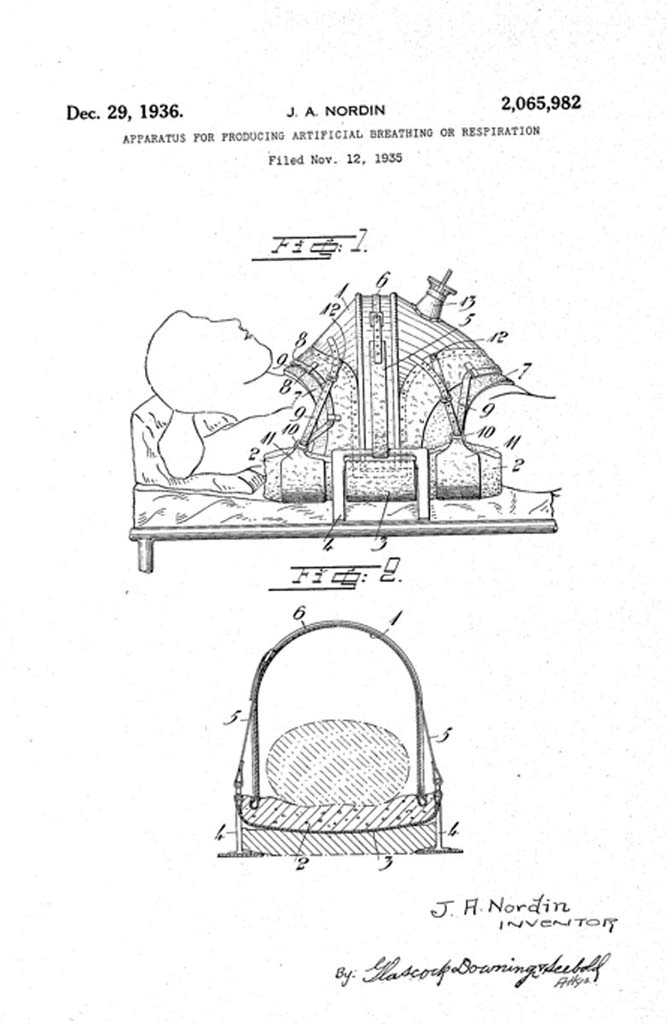
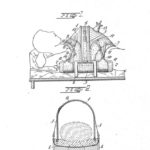
1939 Drinker & Collins
In 1936, J.A. Nordin was awarded a patent for his invention of a “apparatus for producing artificial breathing or respiration.”
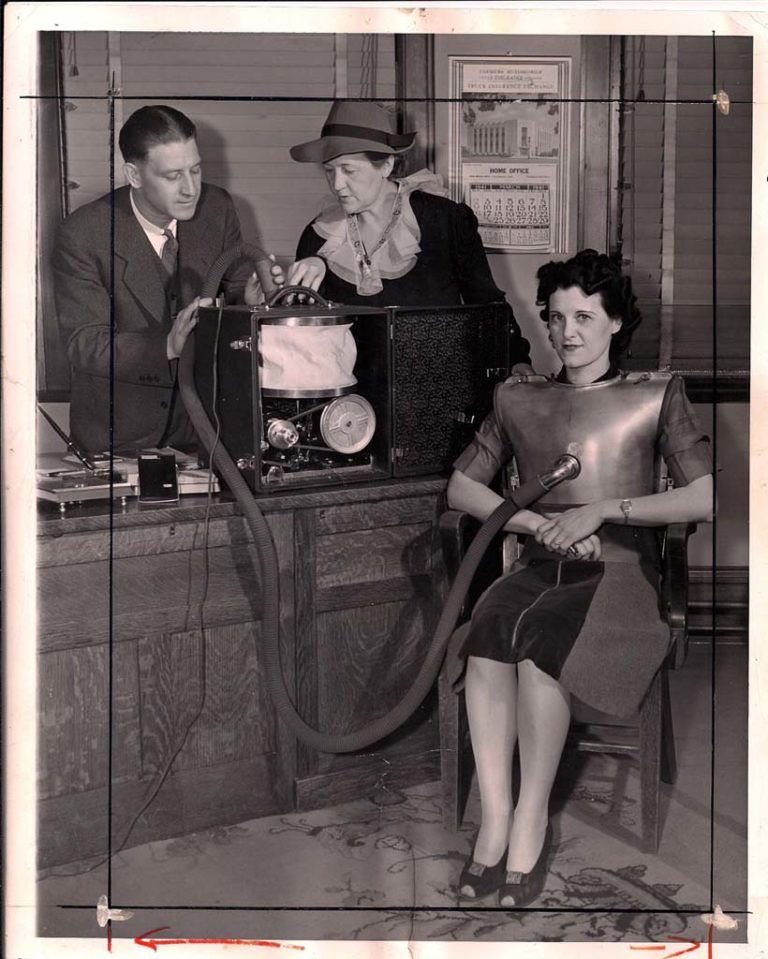
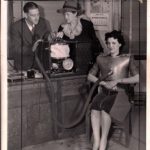
1941 Cuirass
A metal cuirass system is demonstrated in this 1941 photo.
Image from Steve & Mary DeGenaro
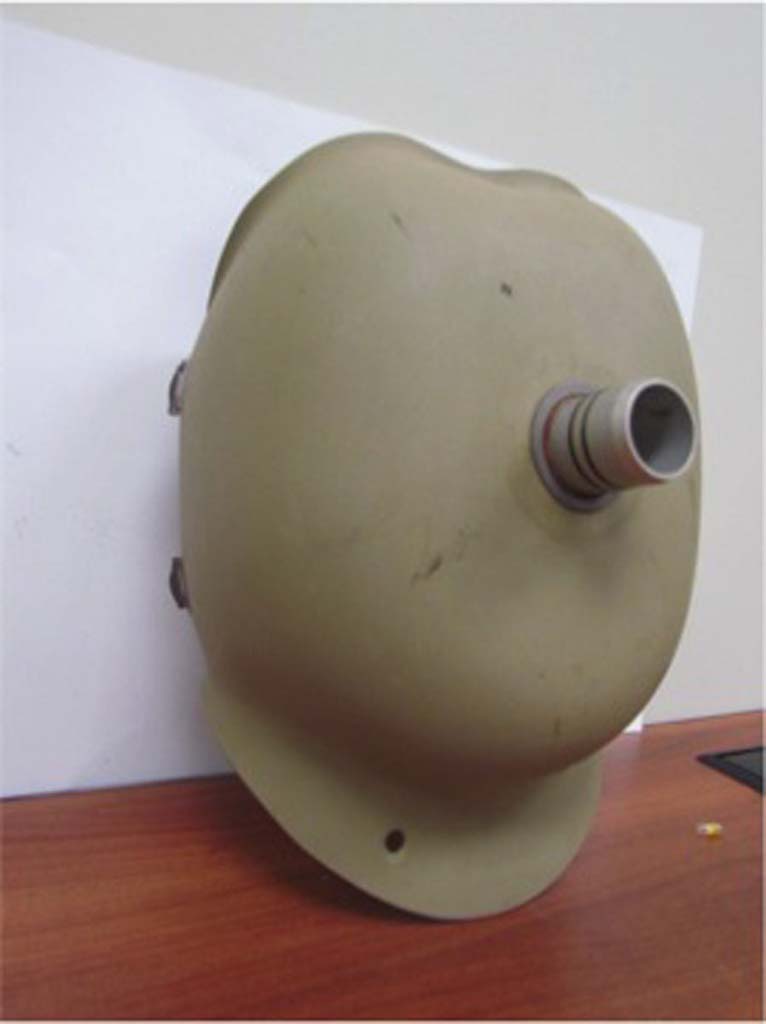
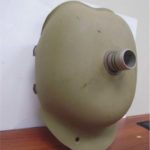
1940s Cuirass Shell
A vintage chest cuirass shell from the 1940s is shown.
Image from Kerry George
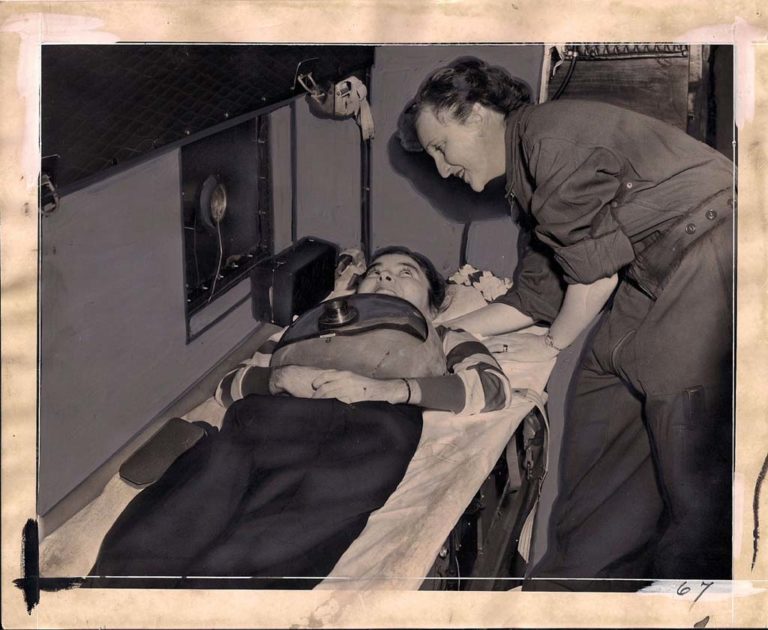
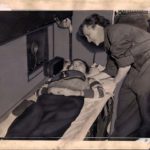
1940s Cuirass
The chest cuirass, a negative pressure ventilator, offered a few advantages over the iron lung. It allowed for better accessibility to the patient. In addition, since the entire patient wasn’t enclosed, it allowed the patient a little more in mobility and changes in position. However, in order to be effective, an air-tight seal still needed to be obtained, and this was somewhat difficult to achieve especially if the patient wasn’t in the supine position.
Image from Steve & Mary DeGenaro
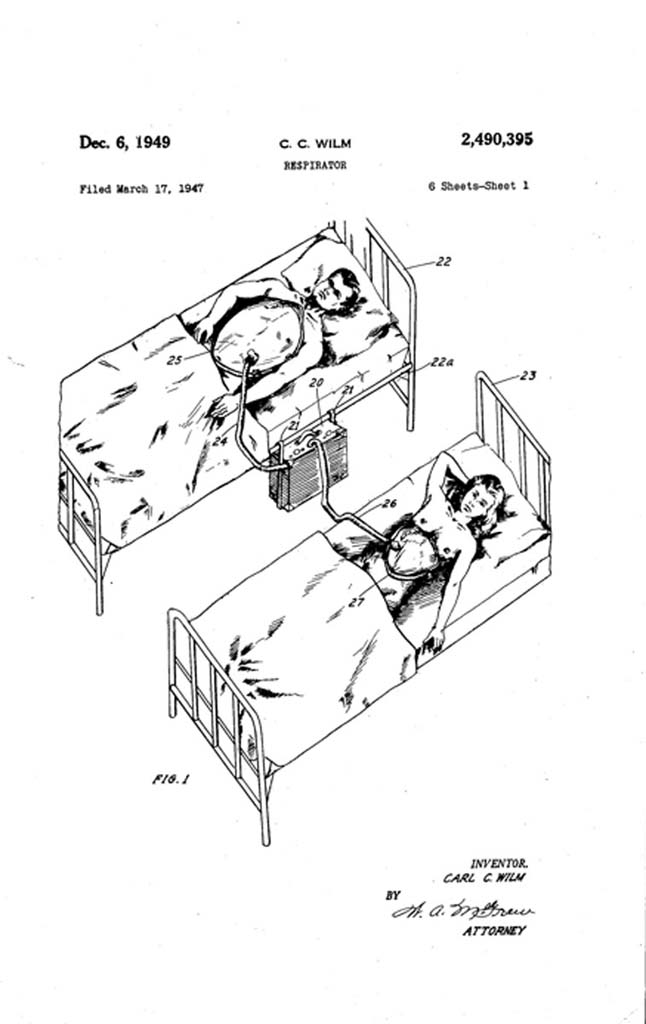
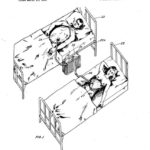
1947 Dual Cuirass Respirator
In March 1947, Charles Wilm filed a patent application for a respirator that could simultaneously power two chest cuirass respirators. The patent was granted on December 6, 1949 and assigned to the J.J. Monaghan Company.
Technicon Huxley Respirator
The Technicon Huxley respirator pump and cuirass was introduced in the 1950s.
Image from the archives of Children's Hospital of Boston
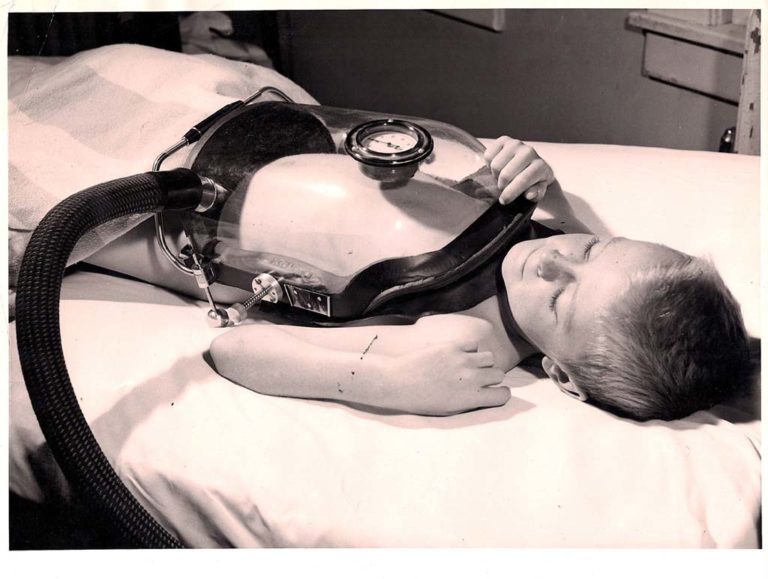

1950s Cuirass
A pediatric patient is shown using a chest cuirass.
Image from Steve & Mary DeGenaro

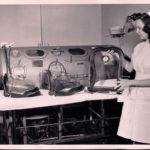
1950s Cuirass Shells
Three lightweight cuirass shells are displayed in front of an "iron lung".
Image from Steve & Mary DeGenaro
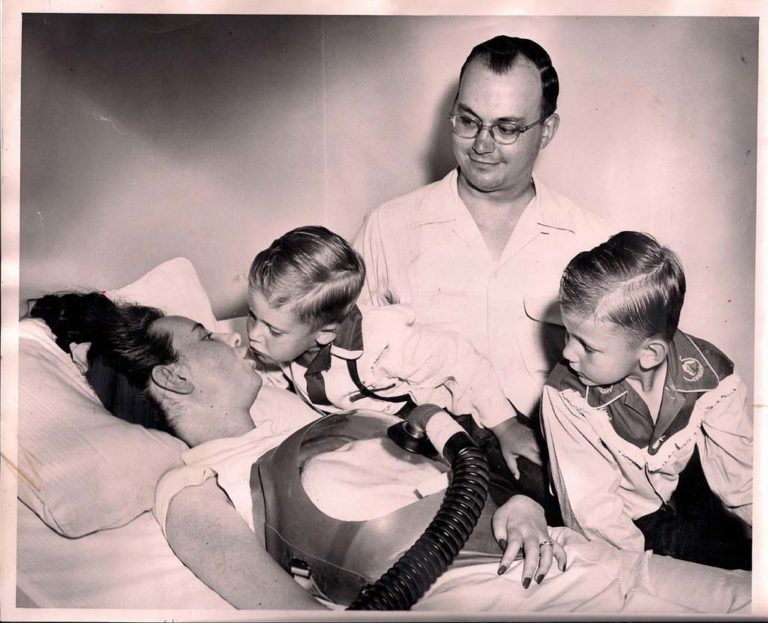
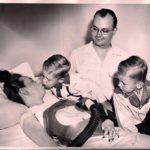
1954 Cuirass
The caption of this photo from the collection of Steve and Mary DeGenaro states “In this June 14. 1954 photo, Mrs. Betty Panceusz is home with sons Paul (3) and Gregory (4) and husband Adam after 2 years at Herman Kiefer Hospital in Detroit, Michigan”.
Image from Steve & Mary DeGenaro
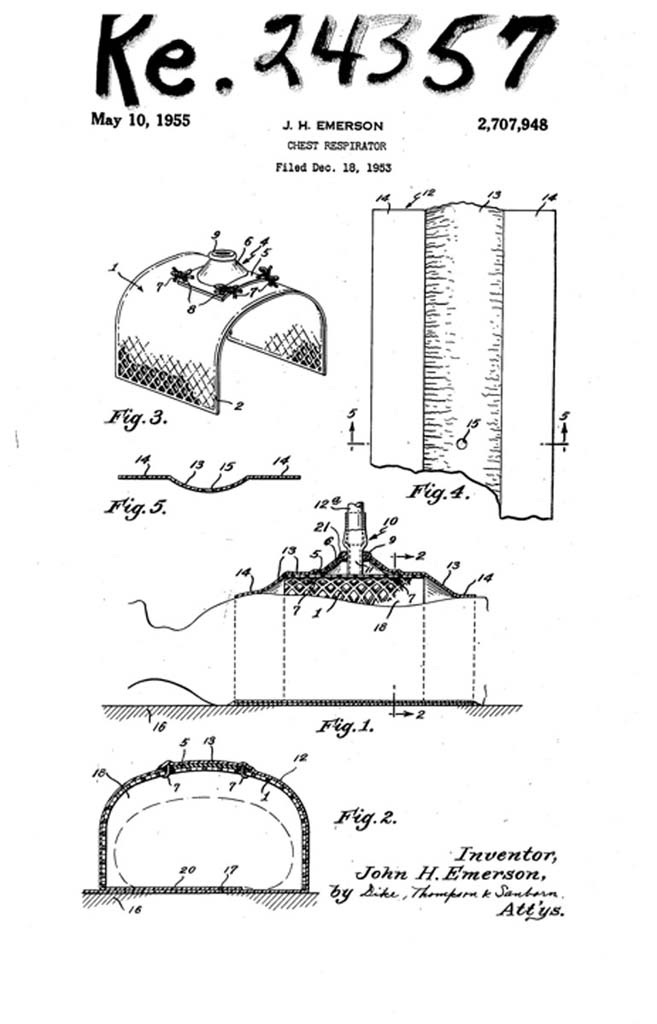
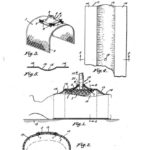
1955 Emerson Chest Respirator
The schematic for patent application for the Emerson Chest Respirator is shown. The application was filed on December 16, 1953 and the patent granted on May 10, 1955.
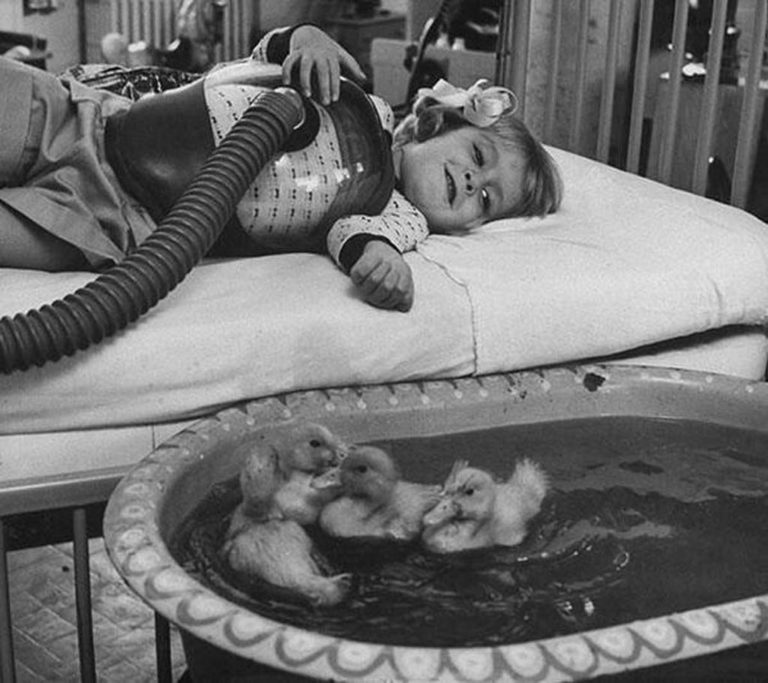
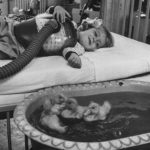
Pediatric Cuirass
in this 1950s photo, a child using a cuirass is being entertained by a pool of ducklings. Many newspaper photos during the polio epidemic tried to promote "normal life" for the children hospitalized with polio.
Image from Brian Walsh
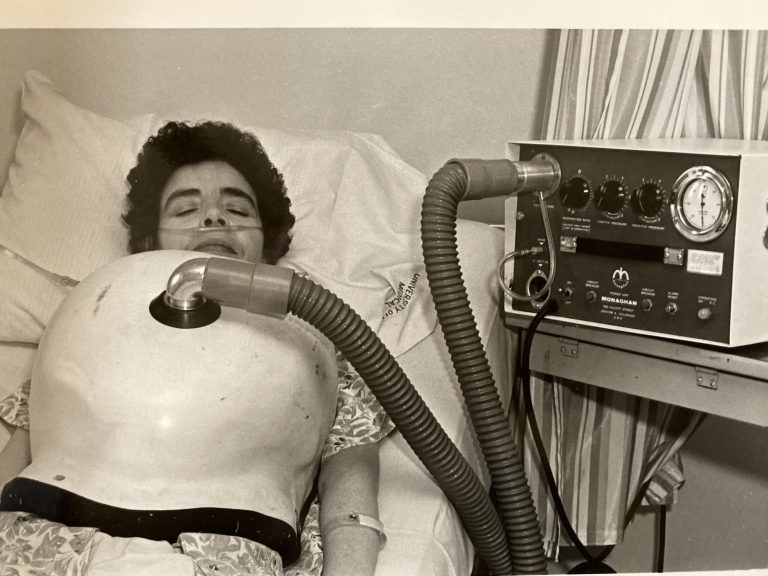
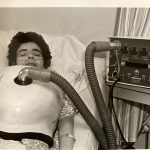
Monaghan Shell
A cuirass with a Monaghan ventilator is pictured.
Image from Barry Make, MD
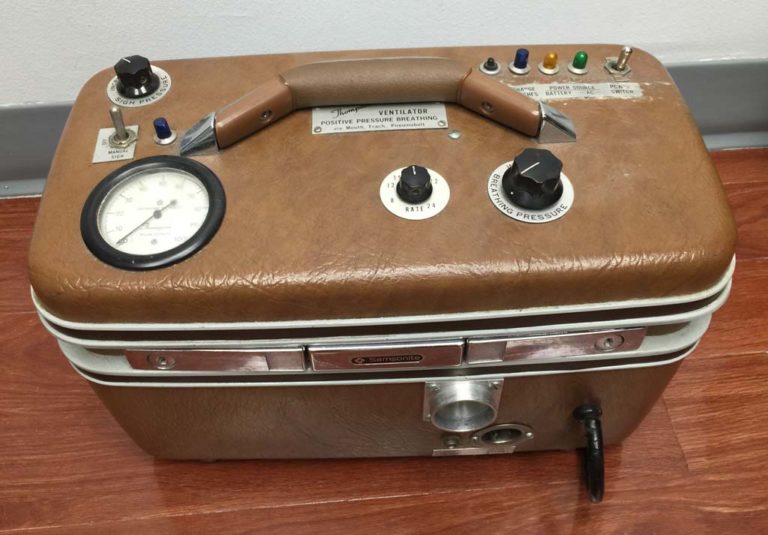
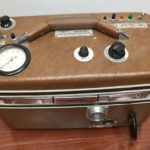
Thompson Ventilator
The Thompson ventilator could be used with a cuirass. The ventilator was contained in a small "make-up" luggage case.
Image from Felix Khusid
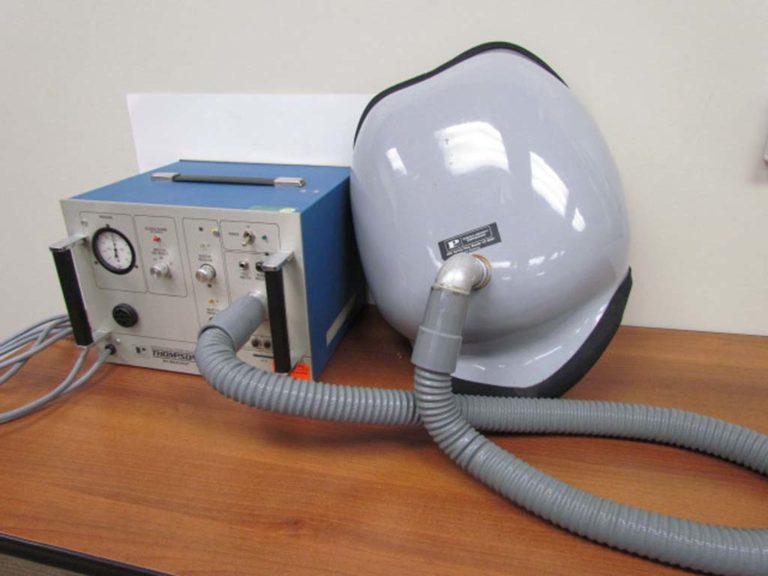
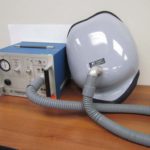
1980s Puritan Bennett Thompson Cuirass
A cuirass system from the 1980s is shown.
Image from Kerry George


Rocking Beds
Several examples of rocking beds are featured in this section of the gallery.
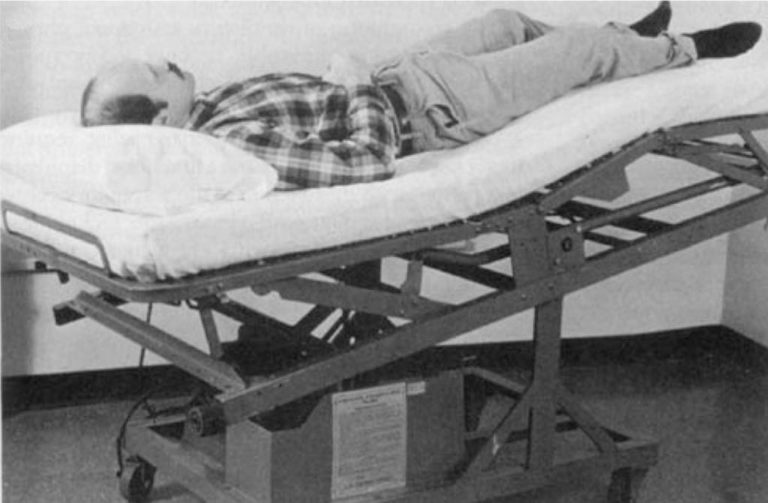
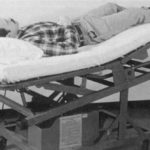
Rocking Bed
The rocking bed, developed in 1932, tilted from head to foot at a rate approximating a patient’s normal respiratory rate. As the bed tilted head-down, the abdominal contents gently pushed on the diaphragm to augment expiration. As the bed tilted head up, gravity allowed the abdominal contents to move by gravity downward, and allowed the diaphragm to descend to augment inspiration.
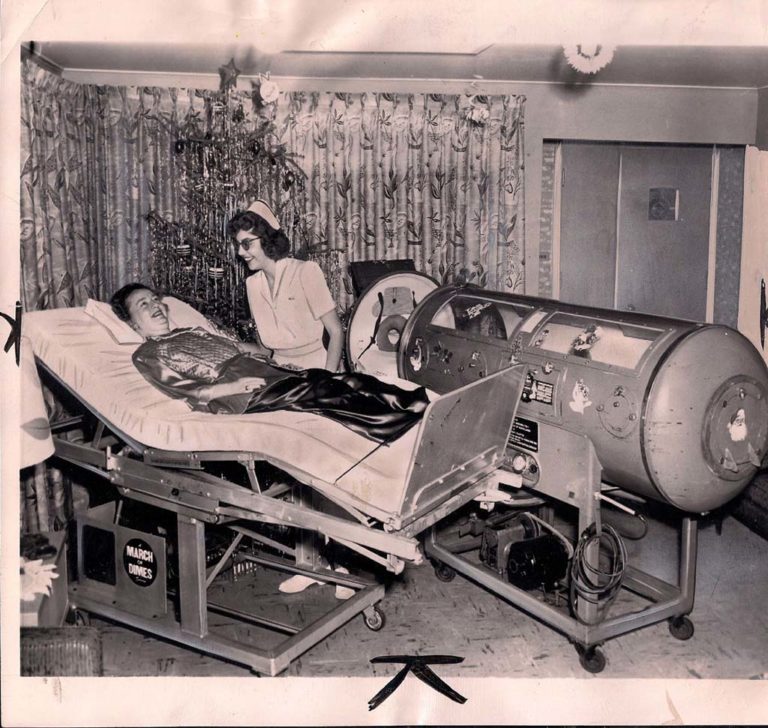
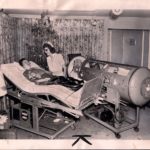
1960 Rocking Bed and "Iron Lung"
A rocking bed is shown next to an "iron lung". Some medical equipment used in the treatment of polio was supplied by the March of Dimes, a nonprofit organization dedicated to the eradication of polio. The March of Dimes sticker is displayed on the base of the rocking bed.
Image from Steve & Mary DeGenaro
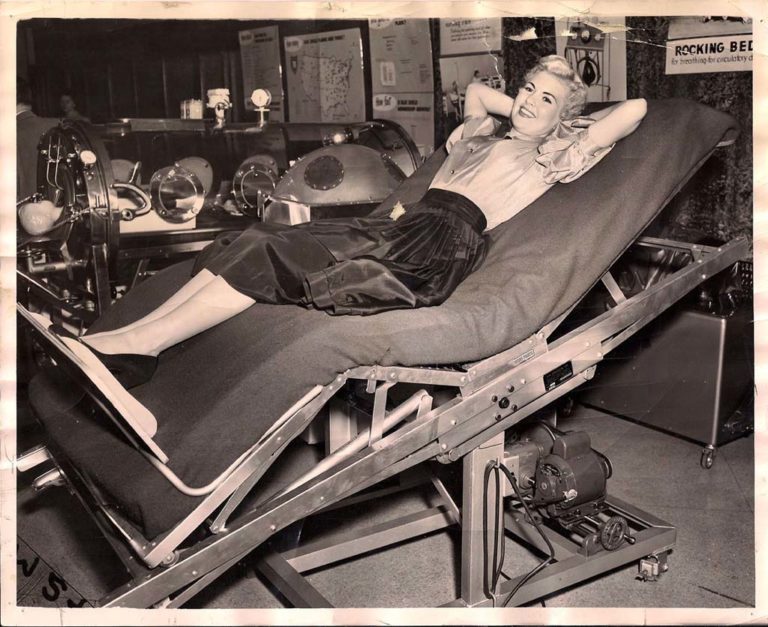
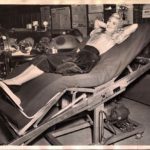
1960 Rocking Bed
In this 1960s photo, a rocking bed is demonstrated at a medical trade show.
Image from Steve & Mary DeGenaro
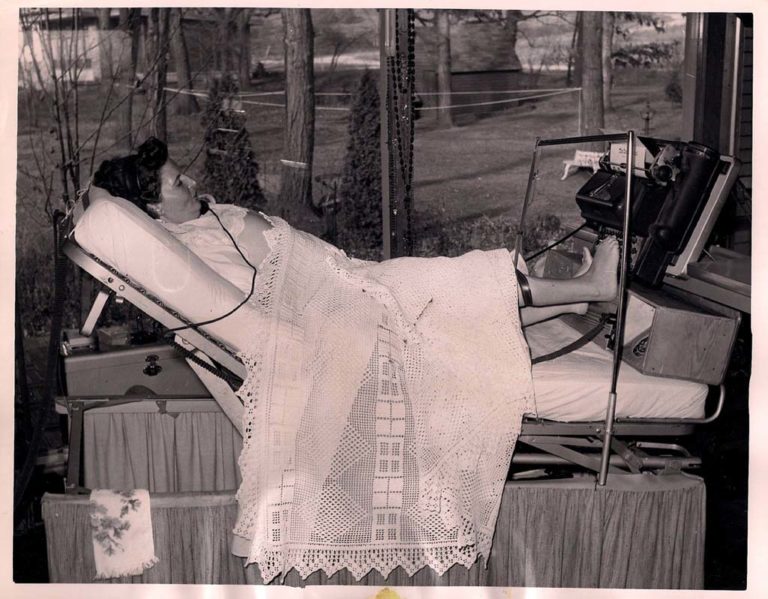
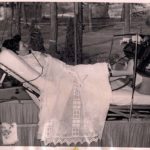
1964
In this November 3, 1964 photo from Dundee, Illinois, the caption states “ Mrs. William Ryan, 40, stricken by polio in 1962 lies in a a rocking bed. She runs an antique store and the Dundee March of Dimes. On her chest is a plastic respirator.”
Image from Steve & Mary DeGenaro
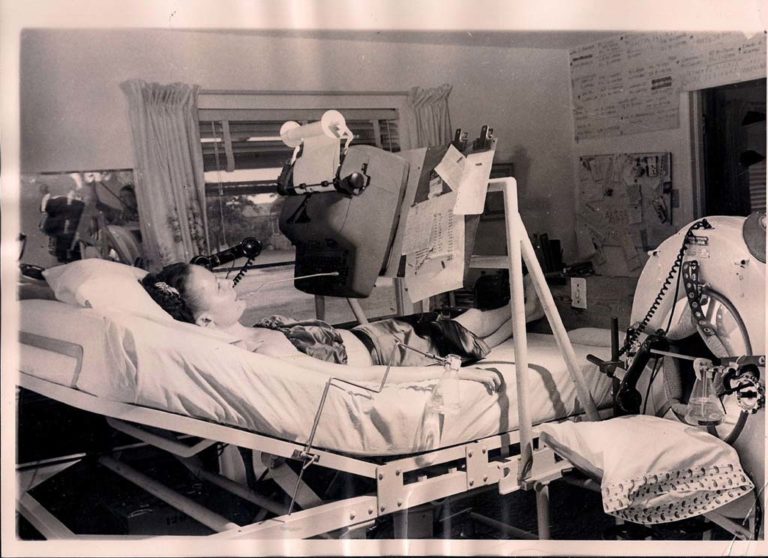
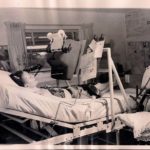
1966
This photo was dated July 1966 from Dallas, TX and captioned: “A Tenacious Hold on Life. Courageous is the best word to describe Mrs. Betty Erickson who has been in an iron lung for over 20 years.” She is pictured here in her rocking bed next to her iron lung.
Image from Steve & Mary DeGenaro


Images to share?
To contribute photos for this gallery, please follow the stated instructions.